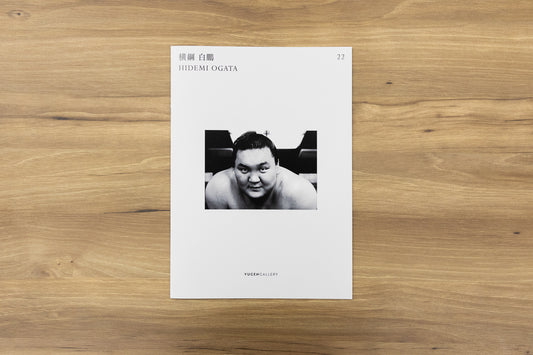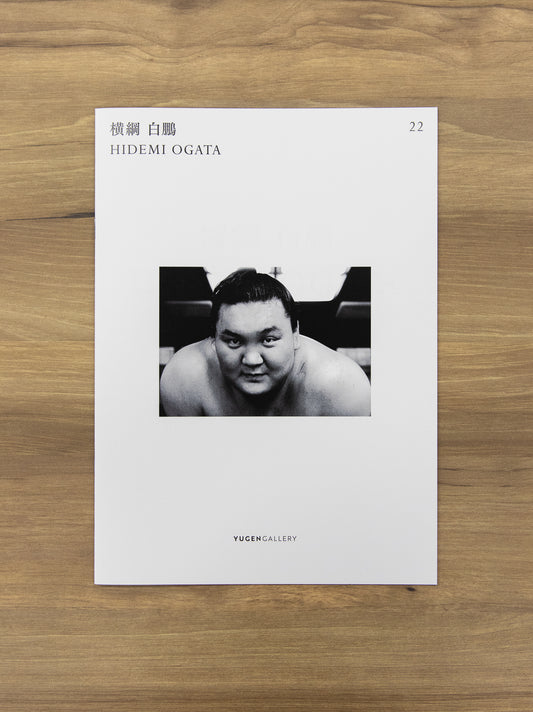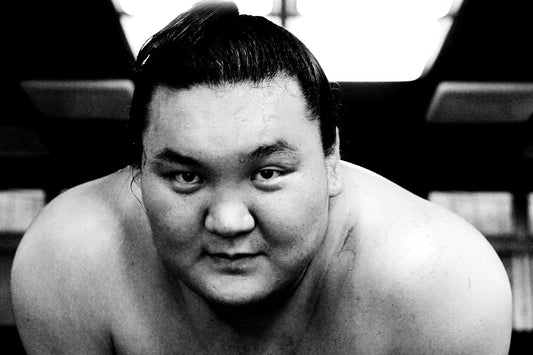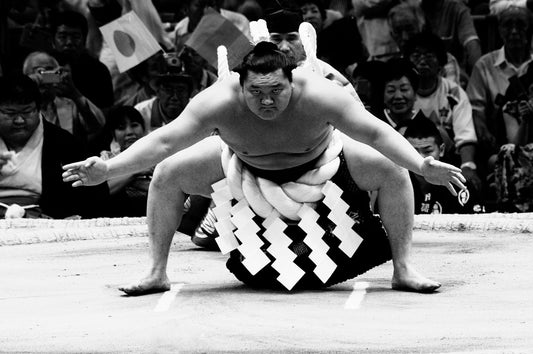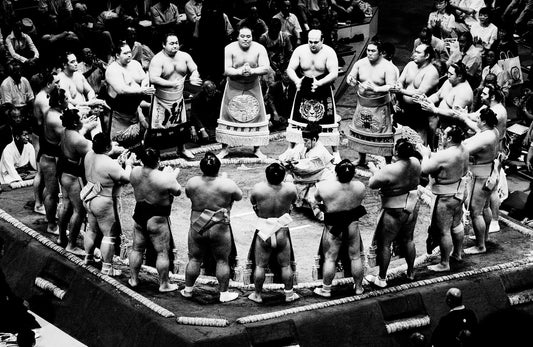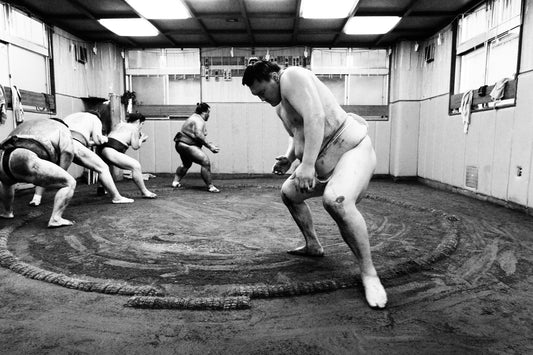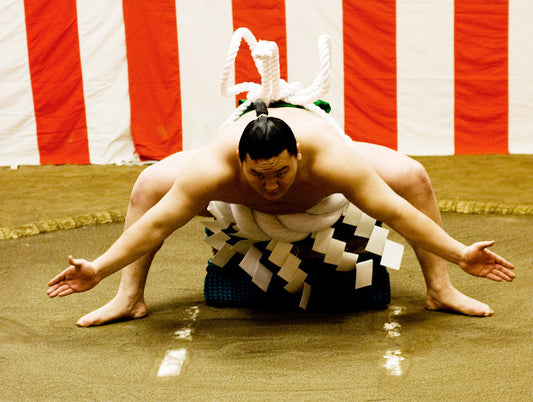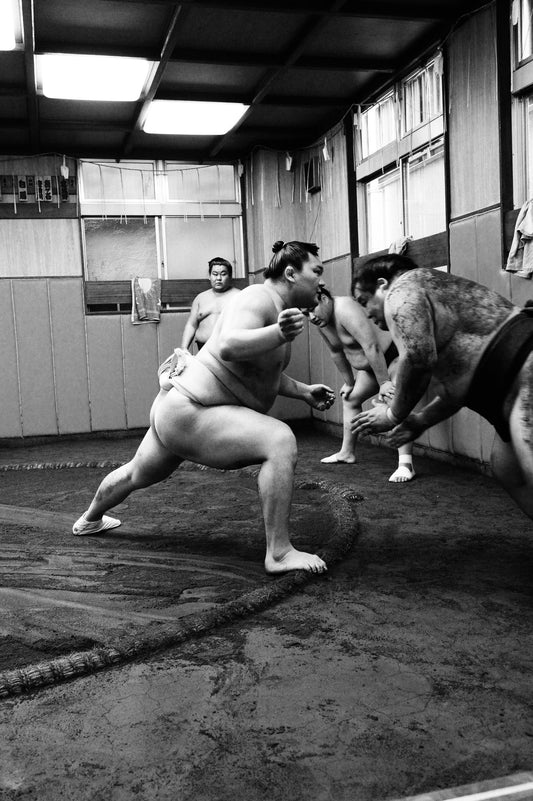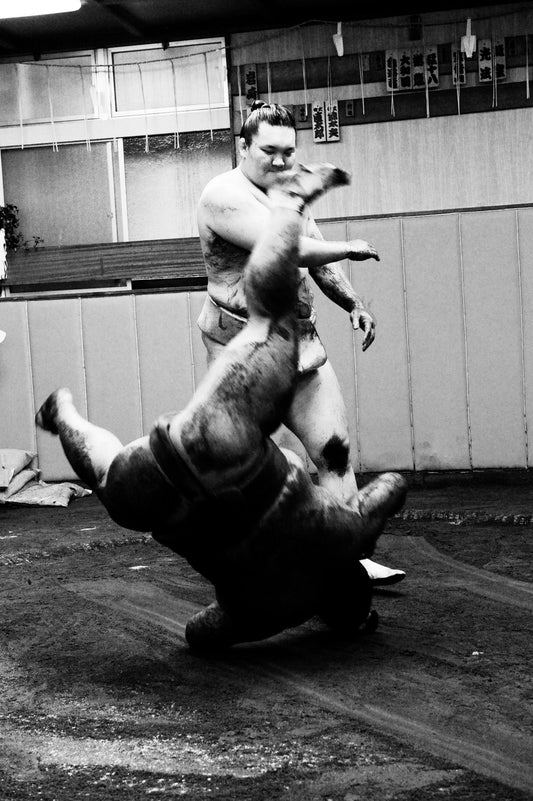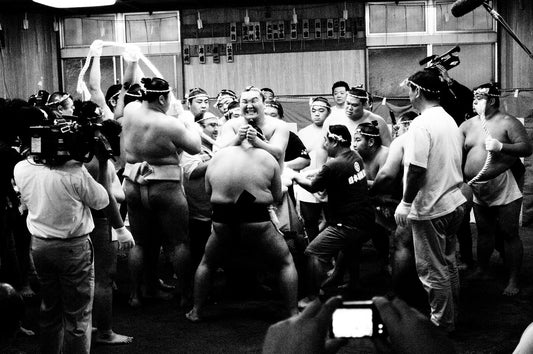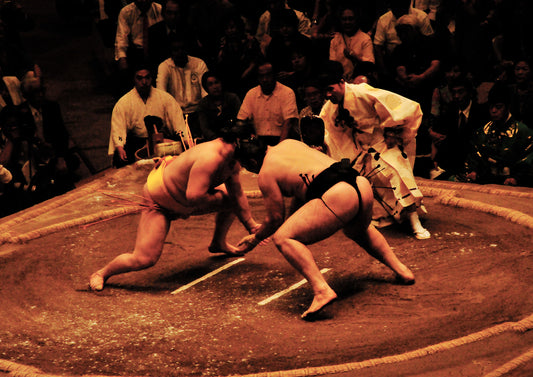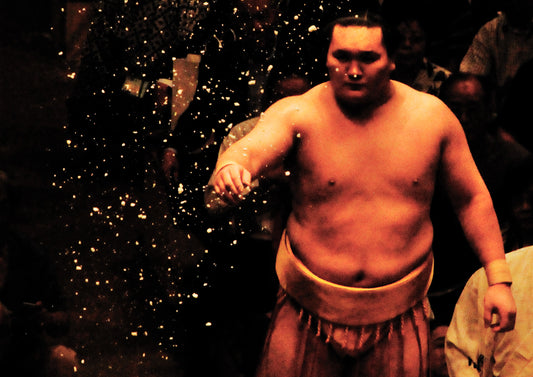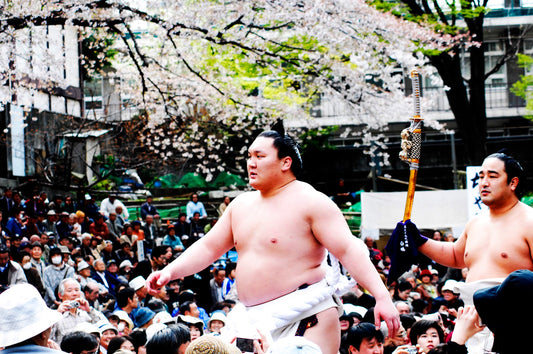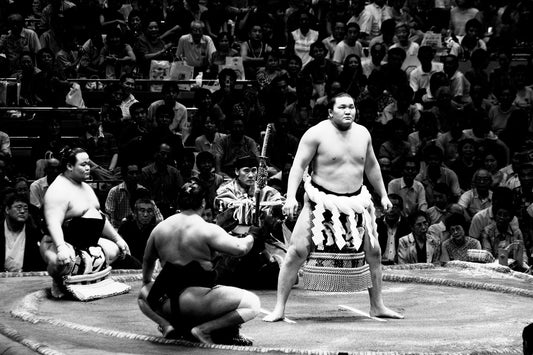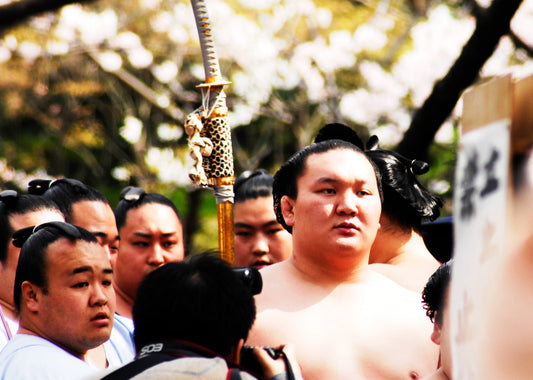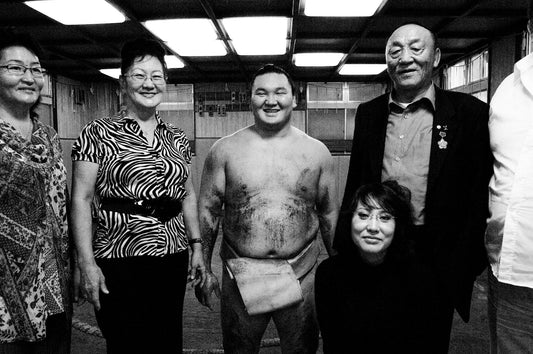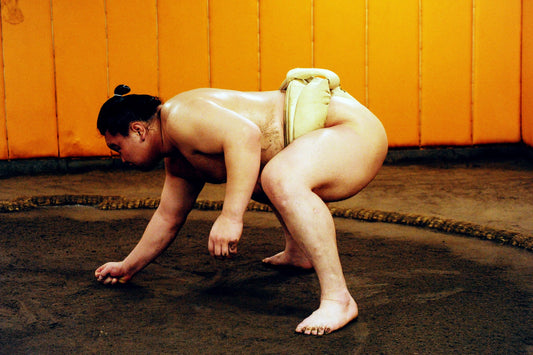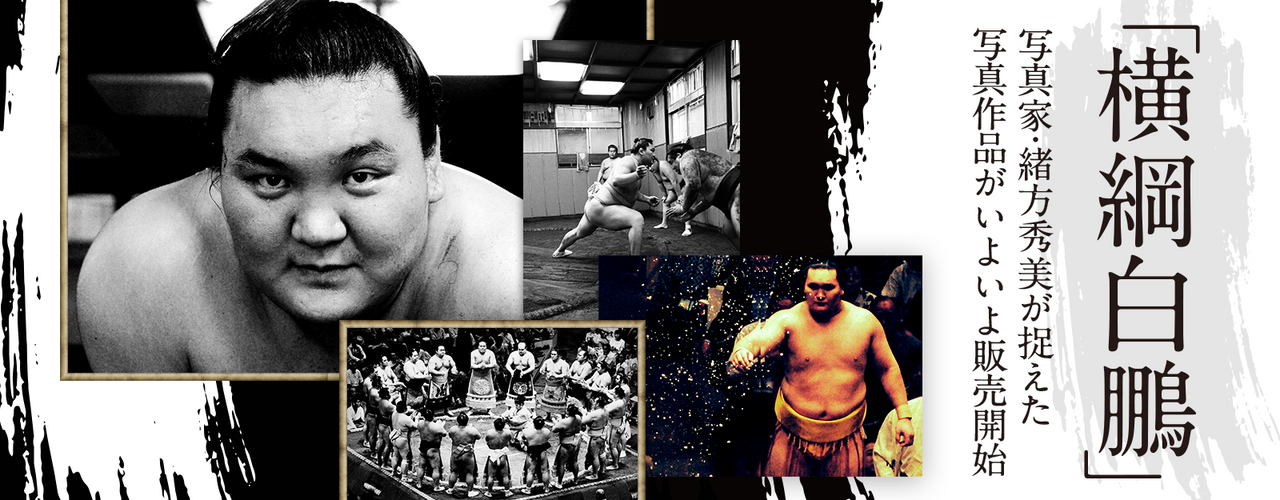
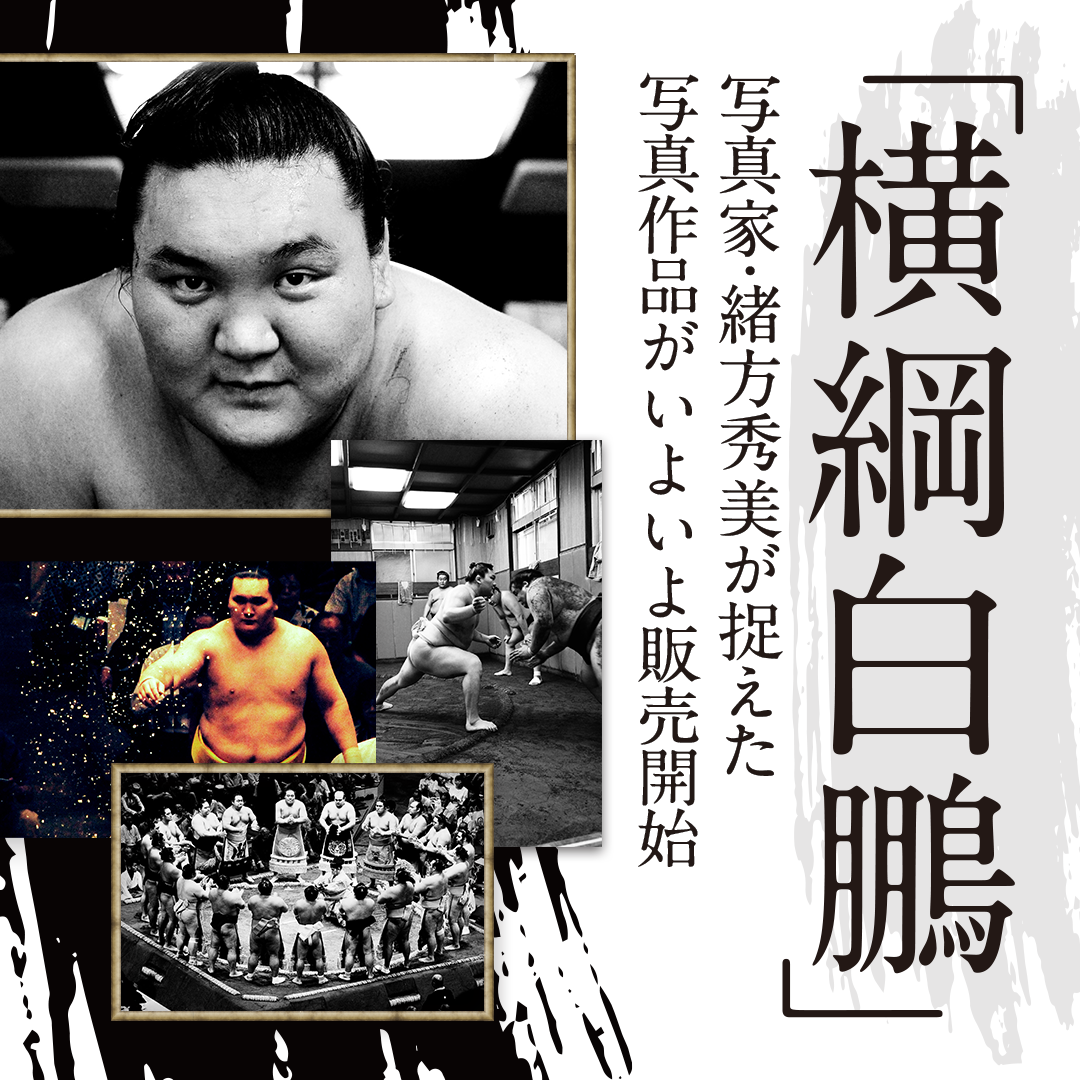
Photographer Hidemi Ogata “Yokozuna Hakuho” work sales special feature
The long-awaited photographs of Yokozuna Hakuho captured by photographer Ogata Hidemi are finally here!
Photographer Ogata Hidemi moved to New York in the 1980s and became friends with world-famous artists such as Andy Warhol. He has continued to photograph legendary icons such as Blankey Jet City photo books, Eikichi Yazawa, B'z, and THE YELLOW MONKEY.
The person she fell in love with as a subject and began following around was the 69th Yokozuna of sumo wrestling, Hakuho (currently Miyagino Oyakata).
He has been attending Miyagino stable since his days as an ozeki, and these precious photographs, capturing the period from his promotion to yokozuna in 2007 to 2010, when he recorded 63 consecutive wins, are now available for sale in limited quantities at the YUGEN Gallery.
Available in two finishes and multiple sizes
You can choose between two types of finishes for the works sold: "framed" or "acrylic mounted." Either way, each piece is hand-finished by a skilled craftsman. In addition, each work will come with a certificate of authenticity with the edition number and Hidemi Ogata's autograph.
You can choose from up to three different sizes, so you can choose the size that best suits your display situation.
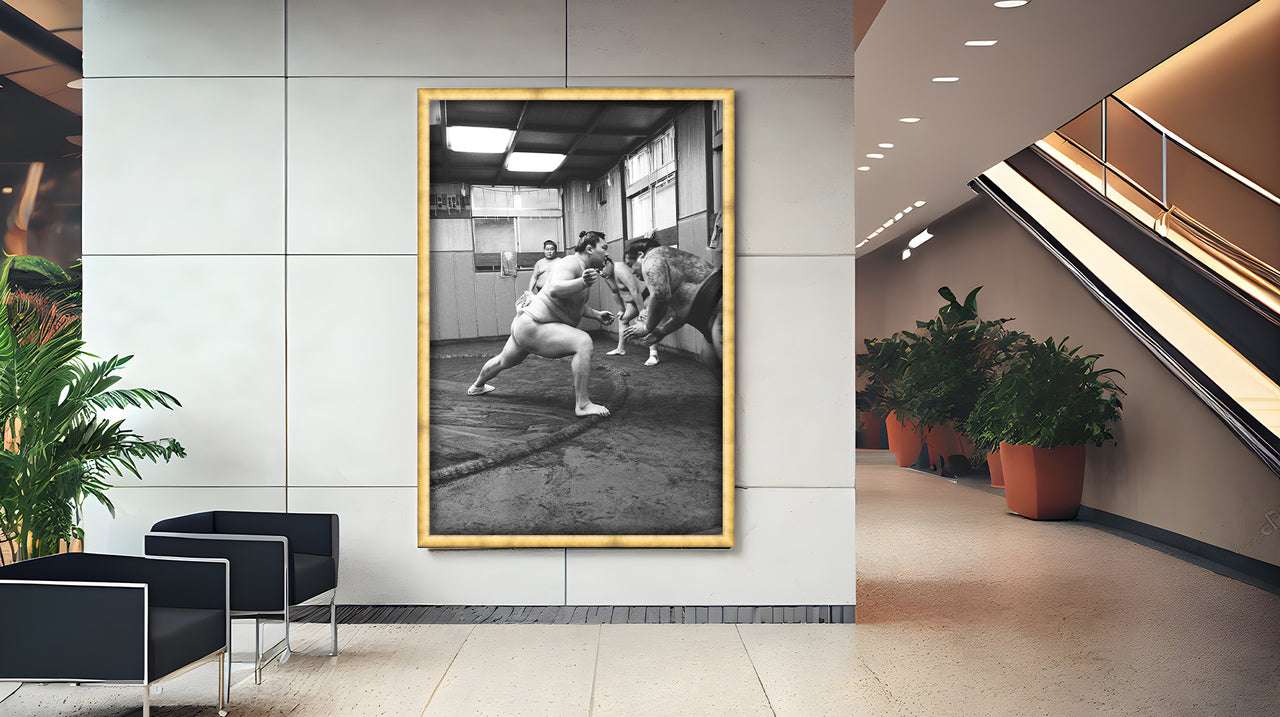
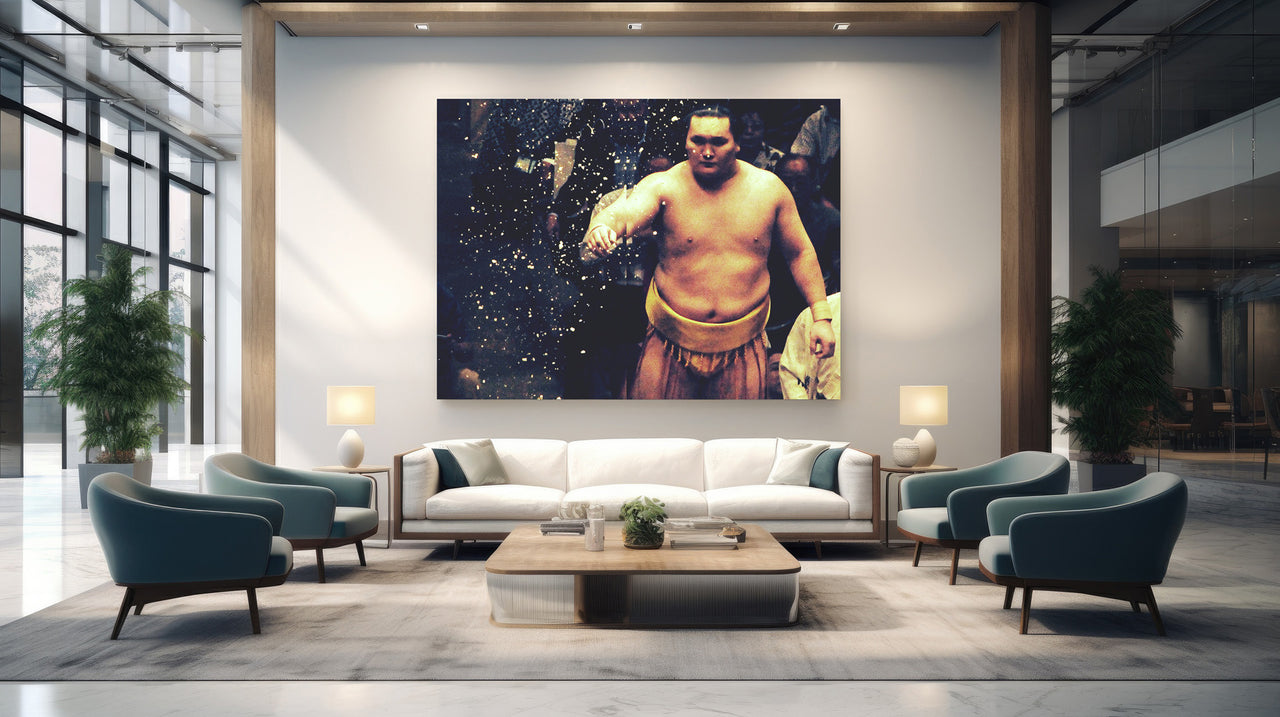
< Finished work >
You can choose to have your work finished in either a frame or acrylic mount.
The framing method used is a glittering gold frame from Larson Juhl, a world renowned framing brand that produces many artistic frames, resulting in a luxurious finish that expresses the dignity and presence of Yokozuna Hakuho.
In the acrylic mounting method, the surface of the printed photograph is treated with an acrylic plate, which makes the beauty of the work stand out even more. The back of the photograph is fitted with a stand called a "floating clog," which gives the work a three-dimensional appearance as if it is floating off the wall when it is exhibited.
Both methods use the latest printing technology called "Giclee," a method of printing photographs. The output is handled by specialized technicians, who reproduce the digital data of the original work in high definition and with a wide color gamut.
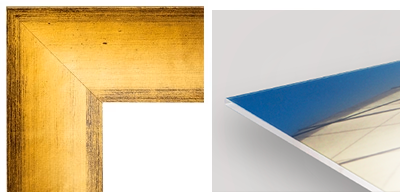
< Sales type >
framed
acrylic mount
List of works for sale
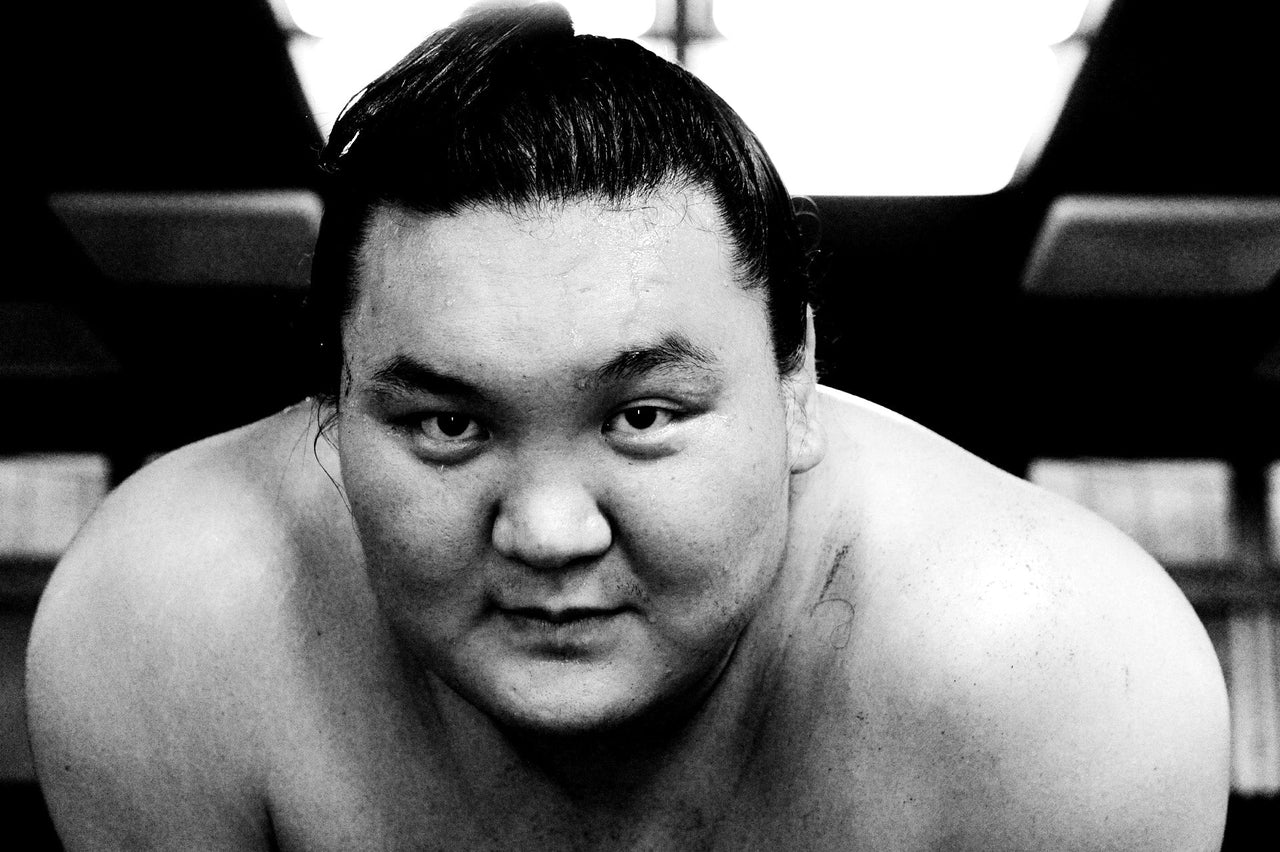
Yokozuna Hakuho I
A portrait taken right after practice. The gaze conveys the trust of a photographer who "shares the same aspirations" as a man who pursues the path of sumo. It was three years since they met, and this shot was only possible because Hakuho approached Ogata, who is not allowed to approach the ring because she is a woman. At Miyagino stable in 2010.
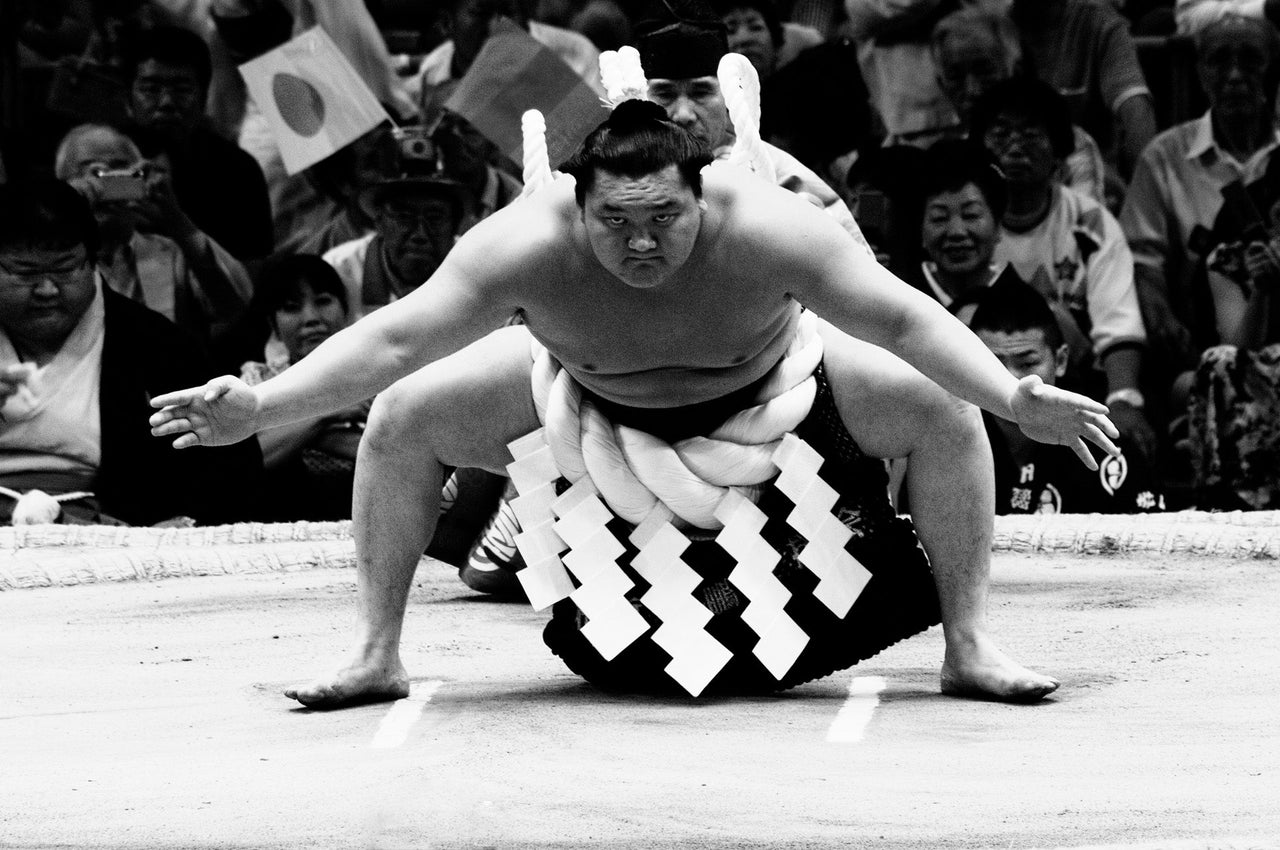
Yokozuna Hakuho II
The dohyo-iri ceremony at the Nagoya Tournament in 2010. The tournament was in jeopardy due to a baseball gambling scandal, and 31 people involved were suspended. Despite the decline in attendance and the lack of live broadcasts, he managed to win three tournaments in a row with no losses. This was the first such feat since the 1949 Summer Tournament, when the 15-day tournament format was established.
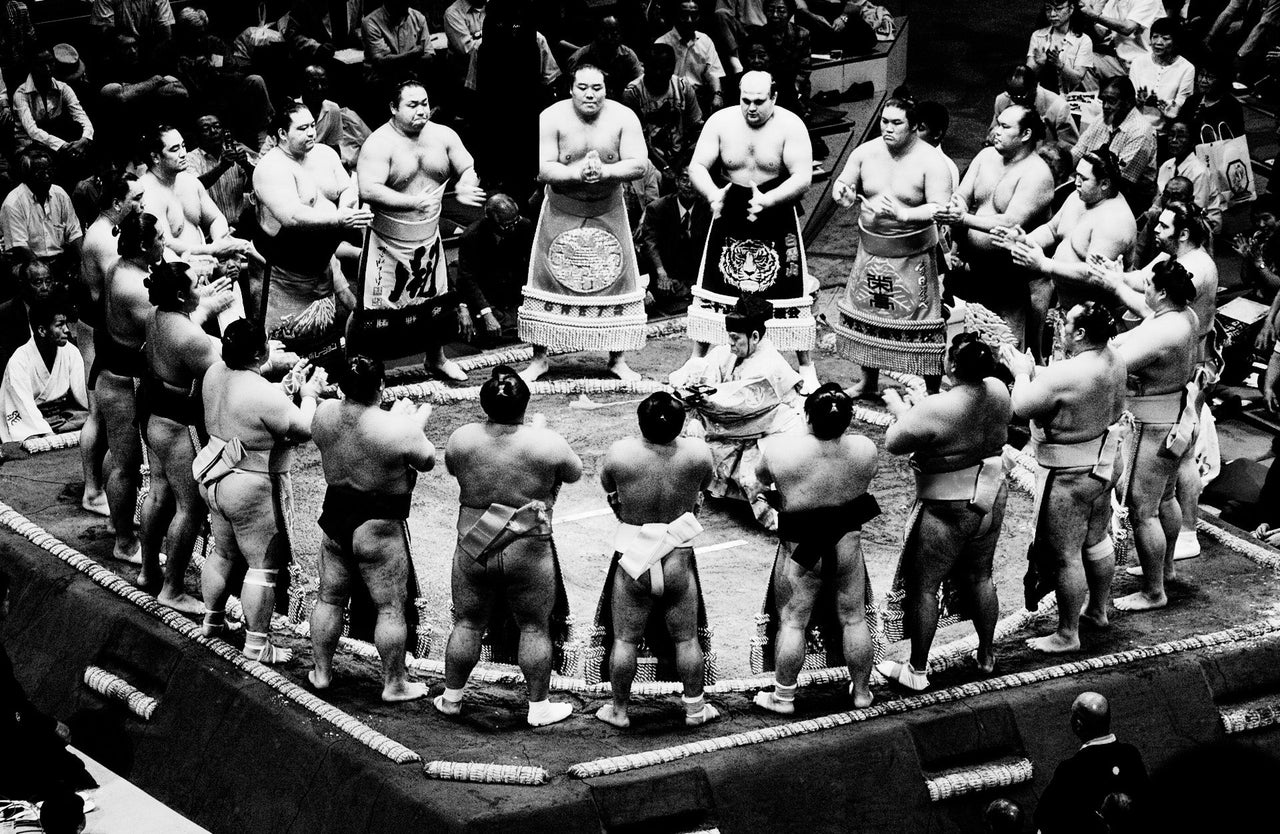
Yokozuna Hakuho III
A scene of the makuuchi wrestlers' ring-entering ceremony at the September 2007 tournament. All the wrestlers from maegashira to ozeki line up wearing their kesho mawashi. They clap their hands, raise their right hands, grab their kesho mawashi, and raise both hands in a series of movements. The formal beauty of sumo takes shape in time and space. At the Ryogoku Kokugikan Sumo Hall.
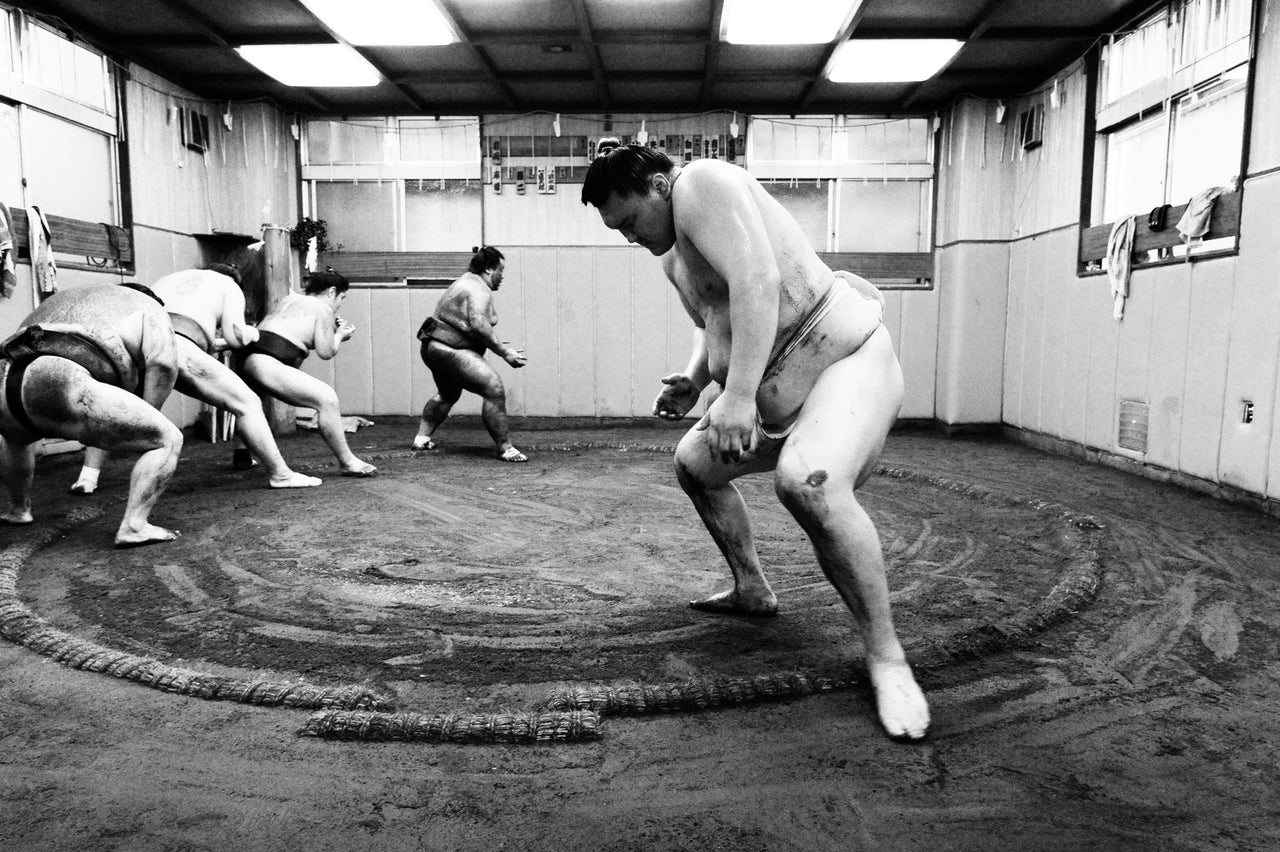
Yokozuna Hakuho IV
This photo was taken in 2007, when he had just started attending the stable. Before it moved to its current location, Miyagino stable was a "very modest" space, Ogata recalls. In that space, he lowered his hips and took slow steps, one by one, as if to feel the feel of the soil. He valued daily training more than anyone else.
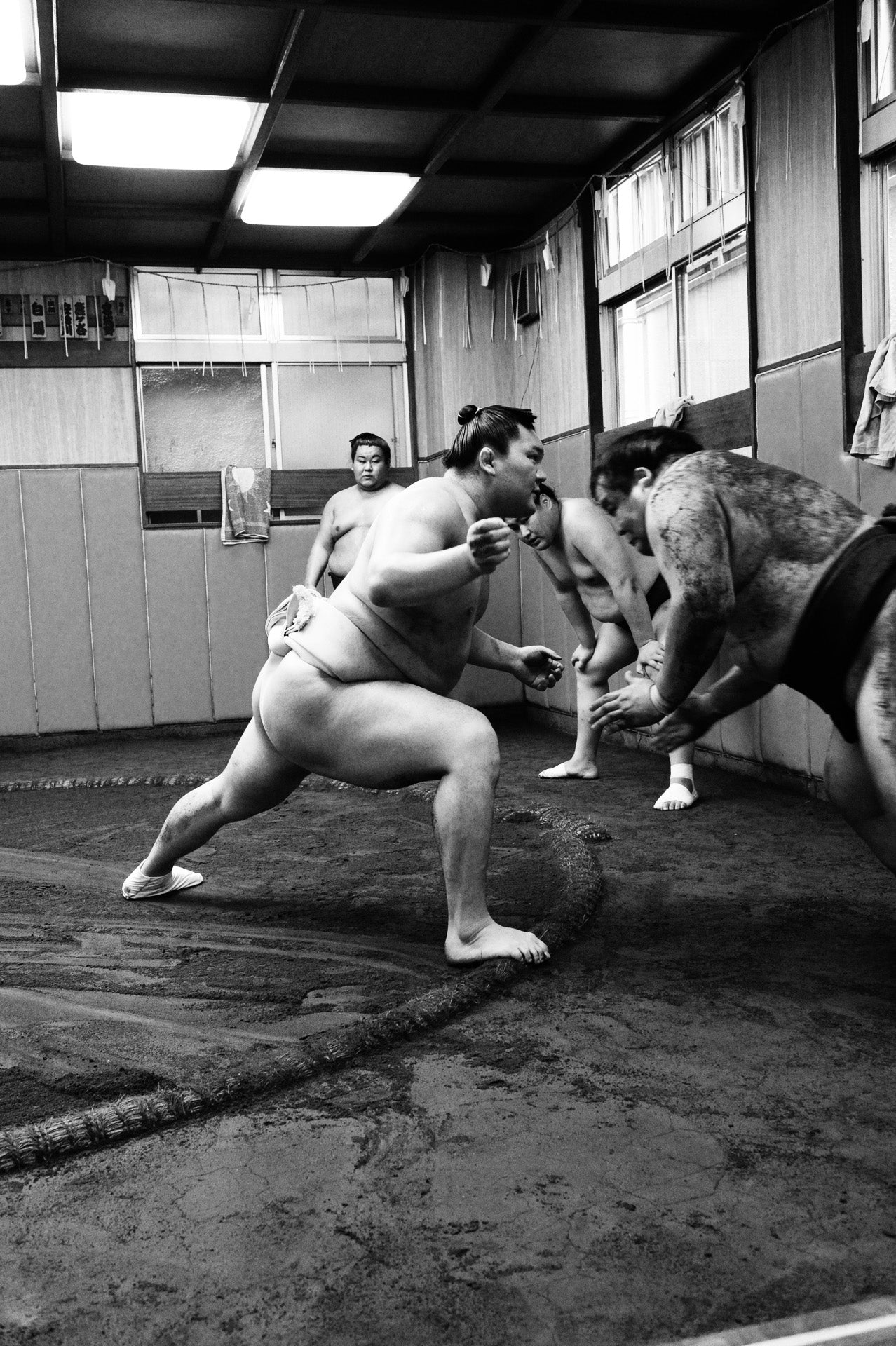
Yokozuna Hakuho V
A practice match filmed at the closest distance possible. Sumo cannot exist without harmony. The wrestlers fight to the point of exhaustion, syncing their movements and breathing with their opponents and refusing to give in. The wrestlers learn from the yokozuna and synchronize their breathing to master the techniques. At Miyagino stable in 2009.
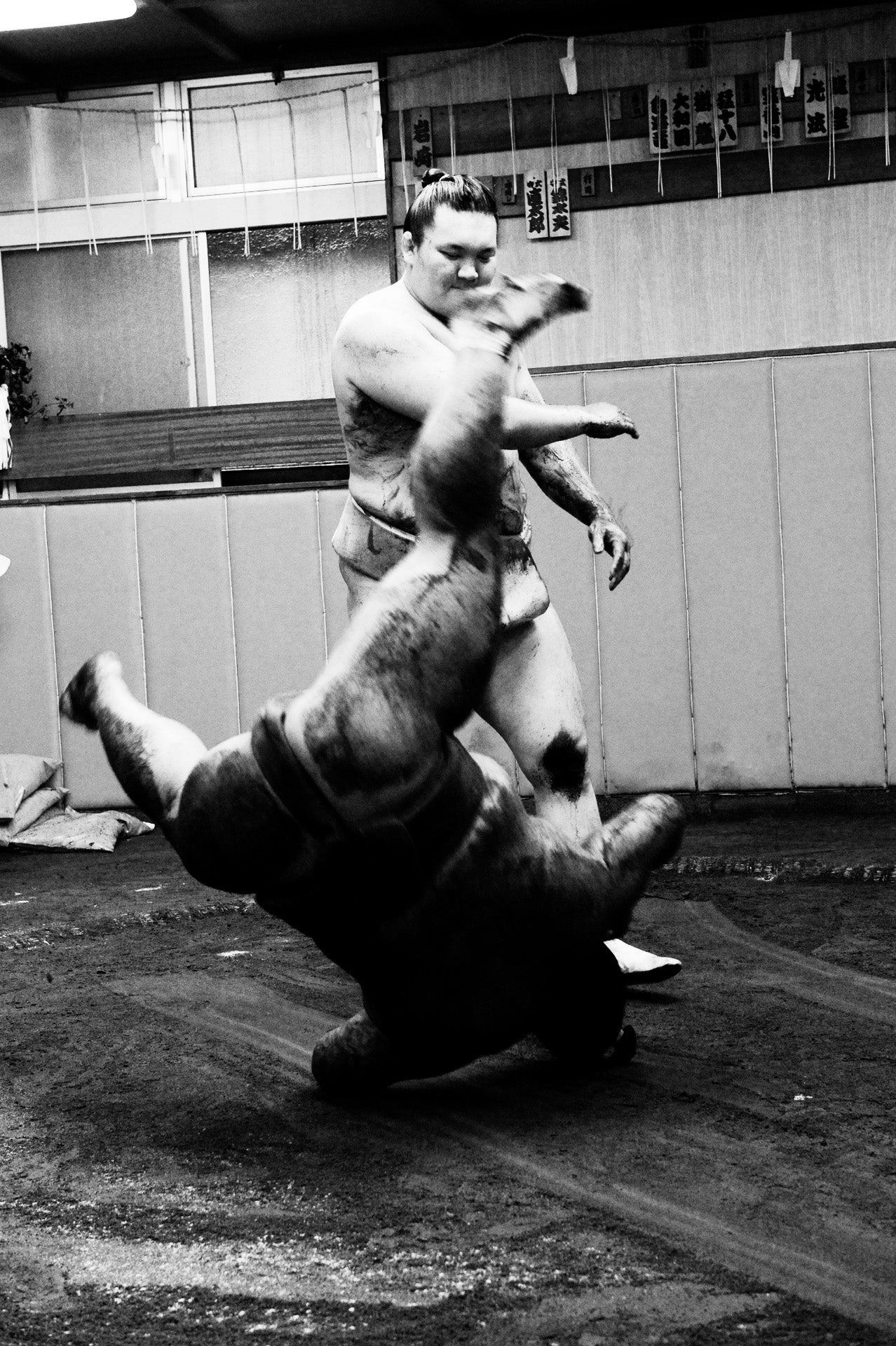
Yokozuna Hakuho VI
Even in fierce matches, the tournament is enveloped in the elegance that comes from its formality. In stark contrast to this special occasion are the daily practice sessions. This is Ogata's "most emotional" moment in his pursuit of sumo. He is hit and knocked back, covered in mud. Monochrome is quietly excited. At Miyagino stable in 2009.
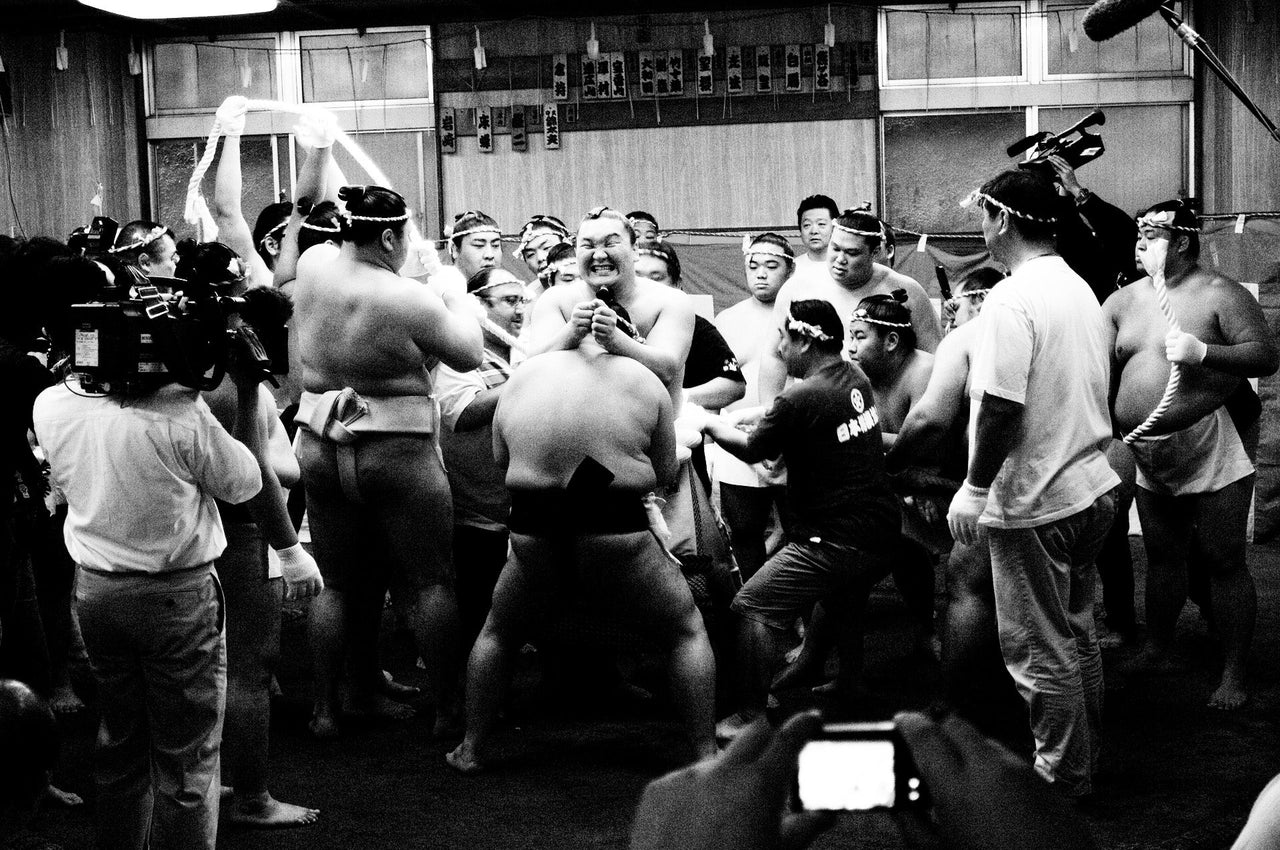
Yokozuna Hakuho VII
The entire stable joined together to weave the rope, and the ceremony took place to the sound of beating drums. Because of the tradition that Yokozuna should not show pain, the image of Yokozuna's face distorted in pain was kept secret. The intention to "record forever the image of Hakuho as a human being who becomes a god" was understood, and the public viewing was permitted. At Miyagino stable in 2007.
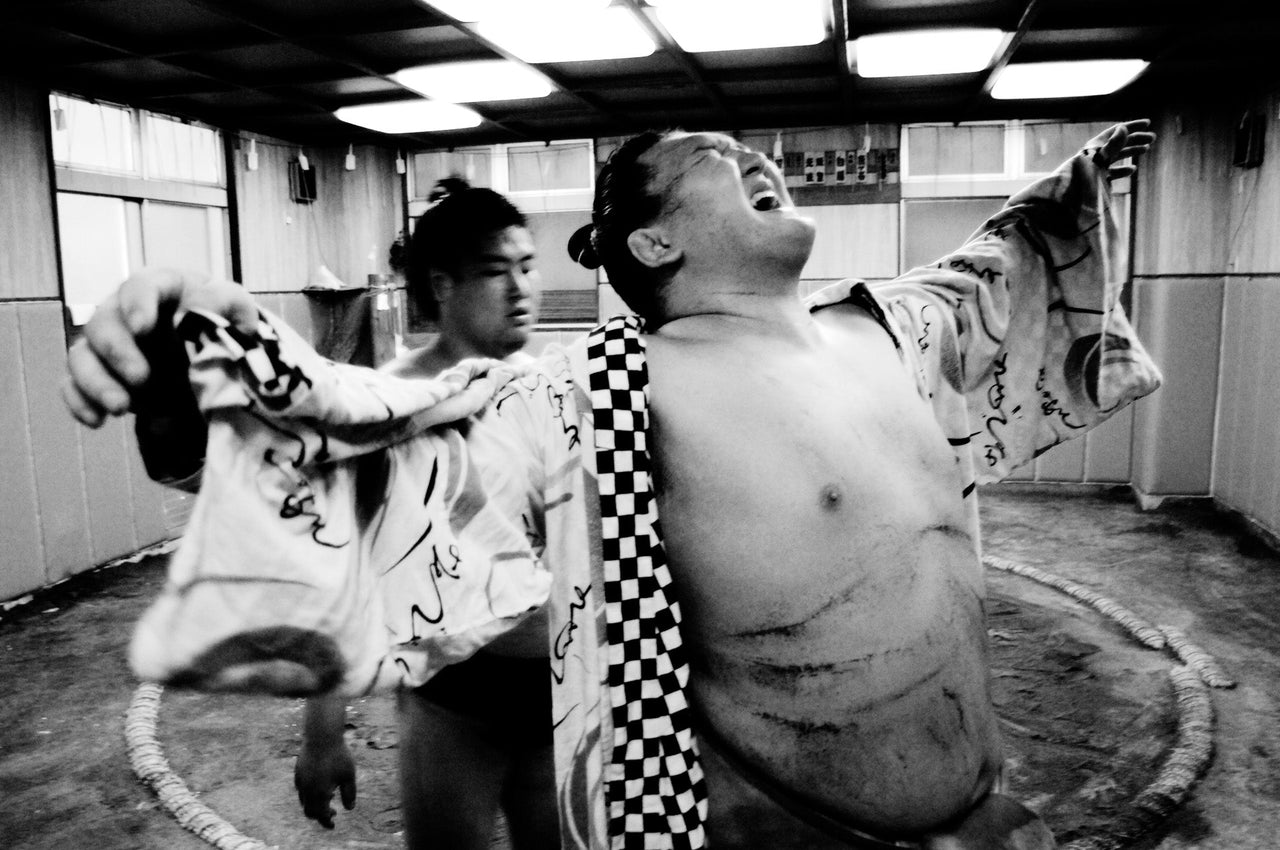
Yokozuna Hakuho VIII
He appears to let out a roar right after training. In a world where politeness is valued, his behavior born from overflowing emotion has often caused controversy. His humanity that everyone loves, and those emotional moments are burned into my memory. This is also the reason why Ogata takes photographs. At Miyagino stable in 2007.
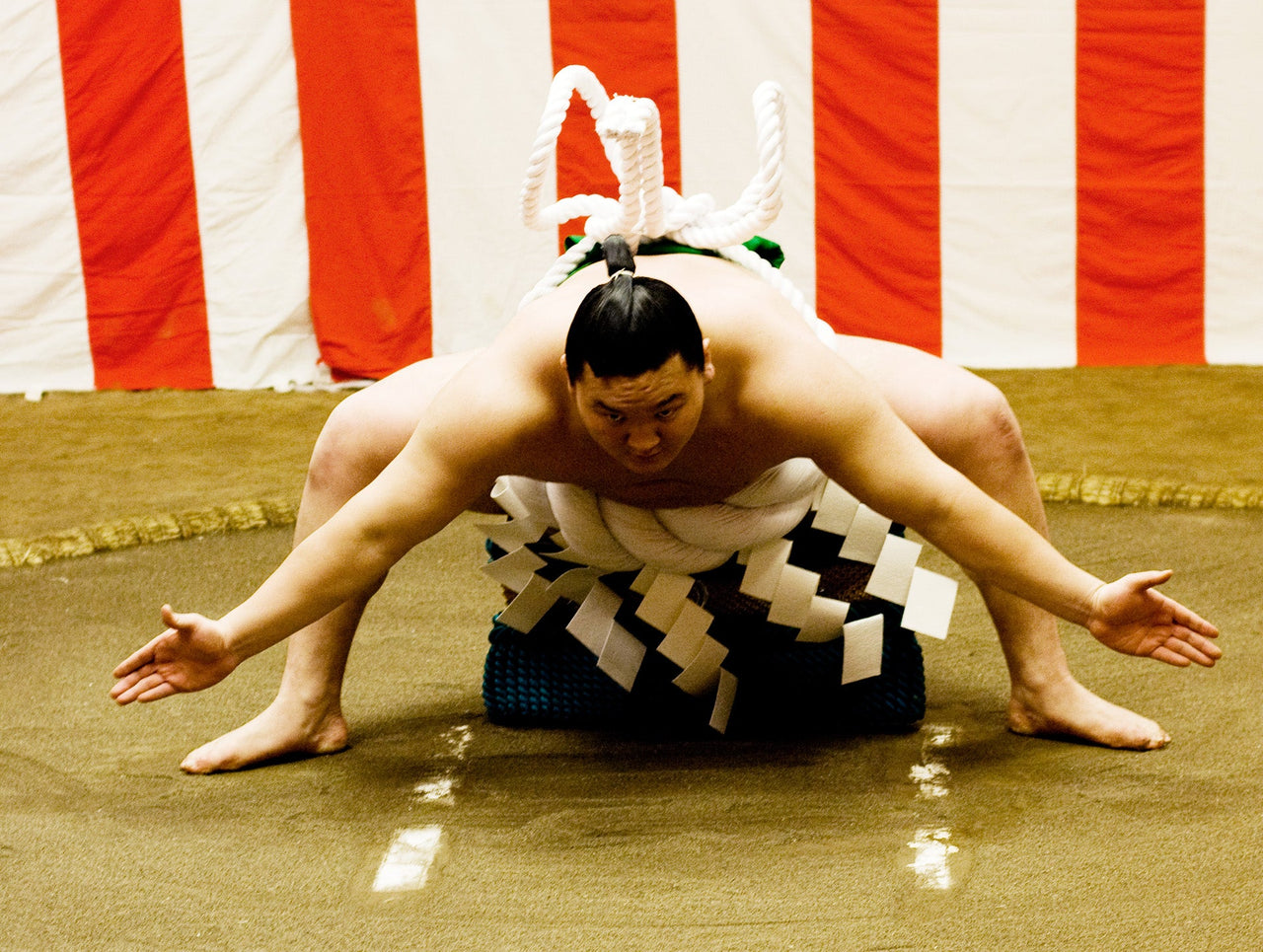
Yokozuna Hakuho IX
A shot of him practicing his Yokozuna dohyo-iri in his brand new mawashi. This is the start of history, breaking the jinx of the sumo world that the "Shiranui-gata" style was short-lived. This is a rare shot that will never be seen in the world, as he is training in his stable and his hairstyle is a topknot instead of the standard large ginkgo. At Miyagino stable in 2007.
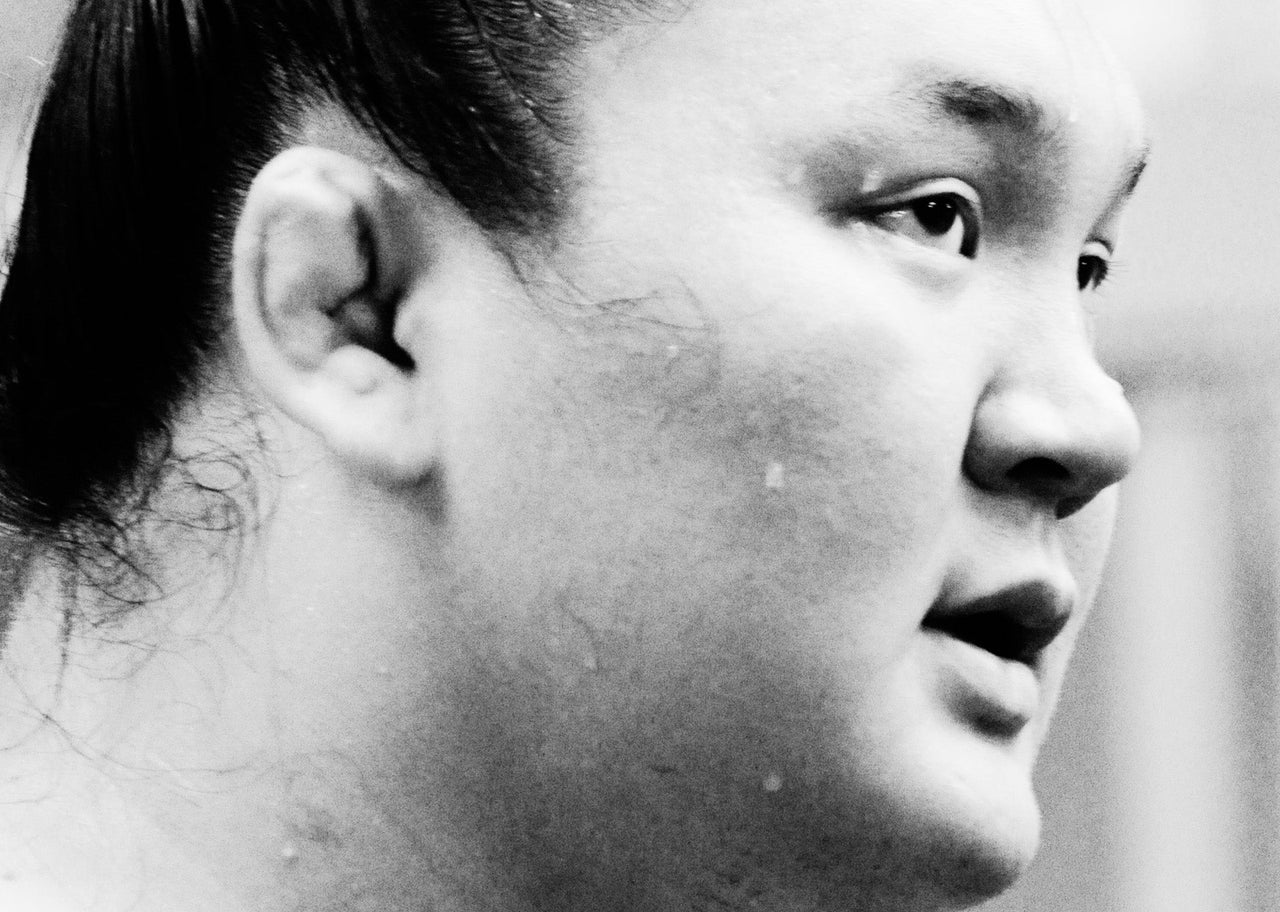
Yokozuna Hakuho X
"I will keep my spirit together and devote myself to sumo so as not to tarnish the title of Yokozuna," was his speech when he was promoted to Yokozuna. When he came to Japan, he was 175cm tall and weighed just over 60kg. He valued the basic exercises of shiko, suriashi, and teppo above all else, and practiced them more diligently than anyone else. In 2007, he joined the Miyagino stable.
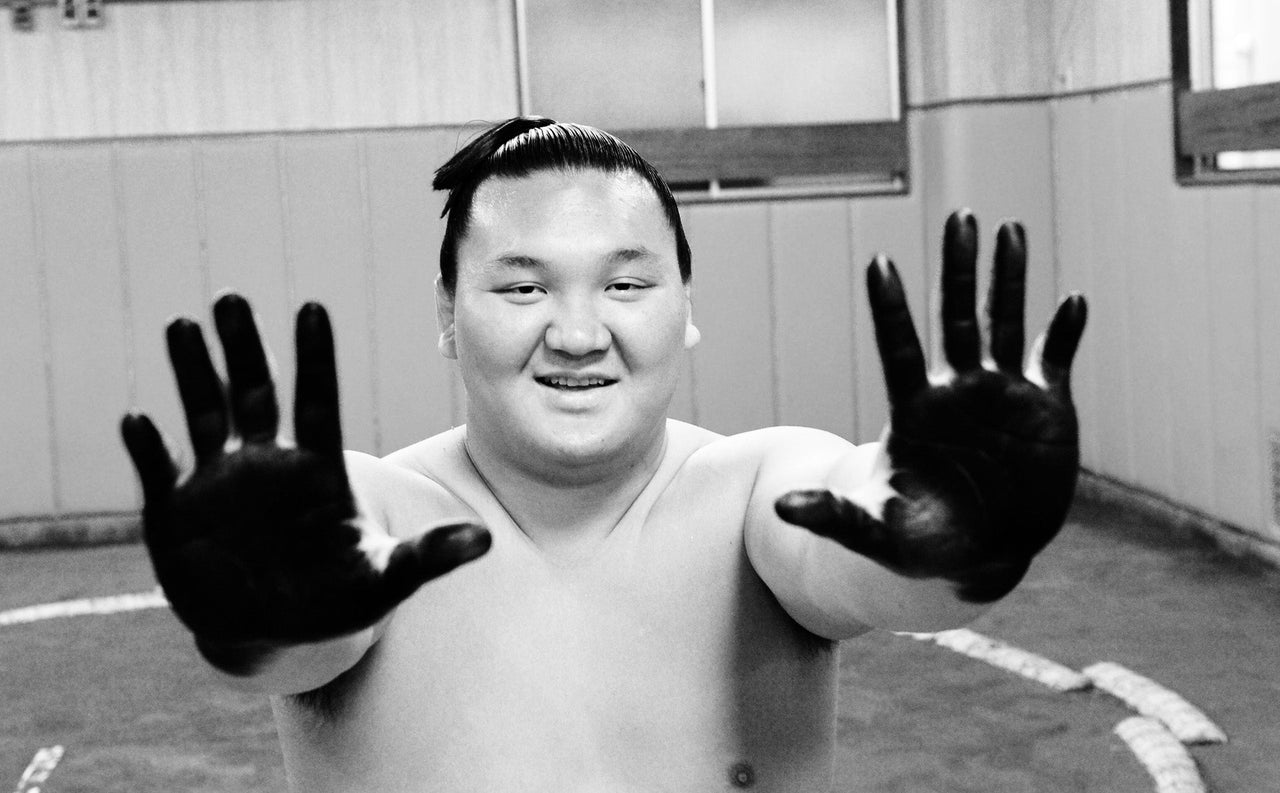
Yokozuna Hakuho XI
Hakuho has been a hot topic on social media for stamping his handprints on 1,500 pieces of colored paper in a day. He is always smiling and eager to please, and is always ready to offer his services. This is evident in the playful way he points his blackened hand towards the camera. At Miyagino stable in 2007.
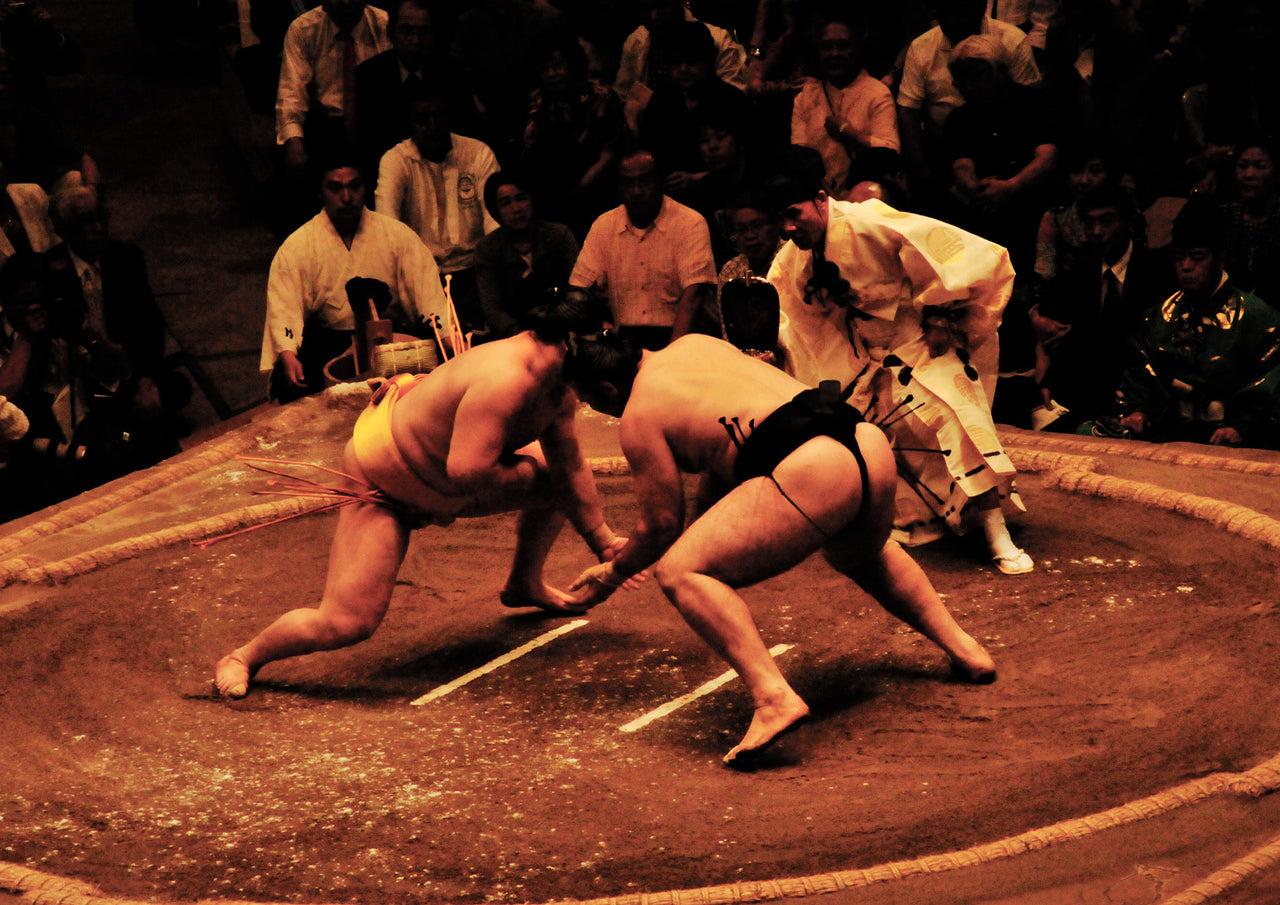
Yokozuna Hakuho XII
The 14th day of the 2010 Summer Tournament. After the scene in the work "Yokozuna Hakuho XIII", he wrestled with Ozeki Kotosho. After an unusual change of mawashi, he won all 14 matches in a ring where he could not afford to lose, extending his winning streak since the first tournament to 31. He vowed to enter his own golden age with the color of his mawashi.
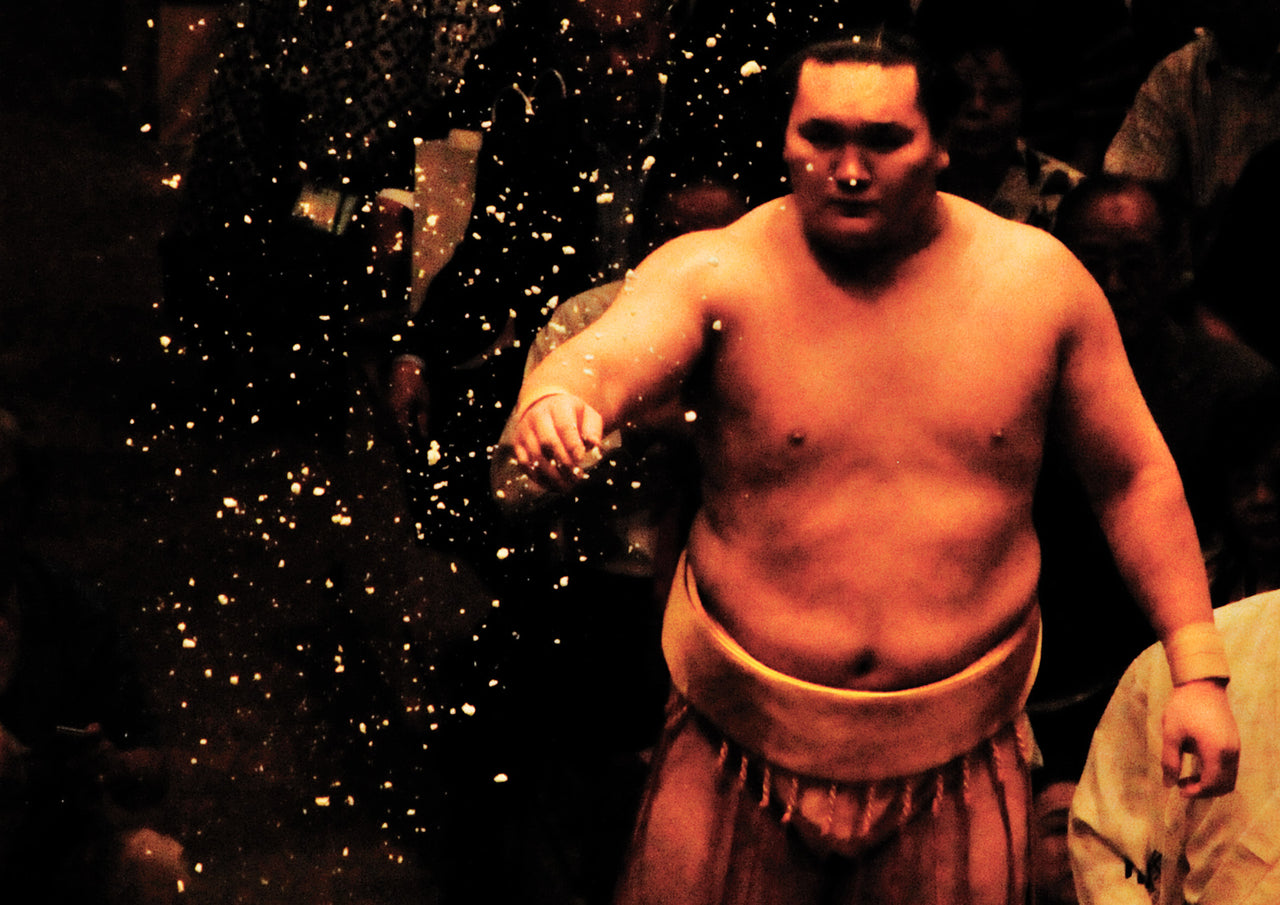
Yokozuna Hakuho XIII
Before the match on the 14th day of the 2010 Summer Grand Sumo Tournament. The mawashi, which had been brown until then, was changed to gold on this day. It is unusual to change mawashi during a tournament. The day before, Hakuho had won his 14th championship, tying the record of former yokozuna Wajima, whom he idolized. He dedicated the golden mawashi, which symbolizes Wajima.
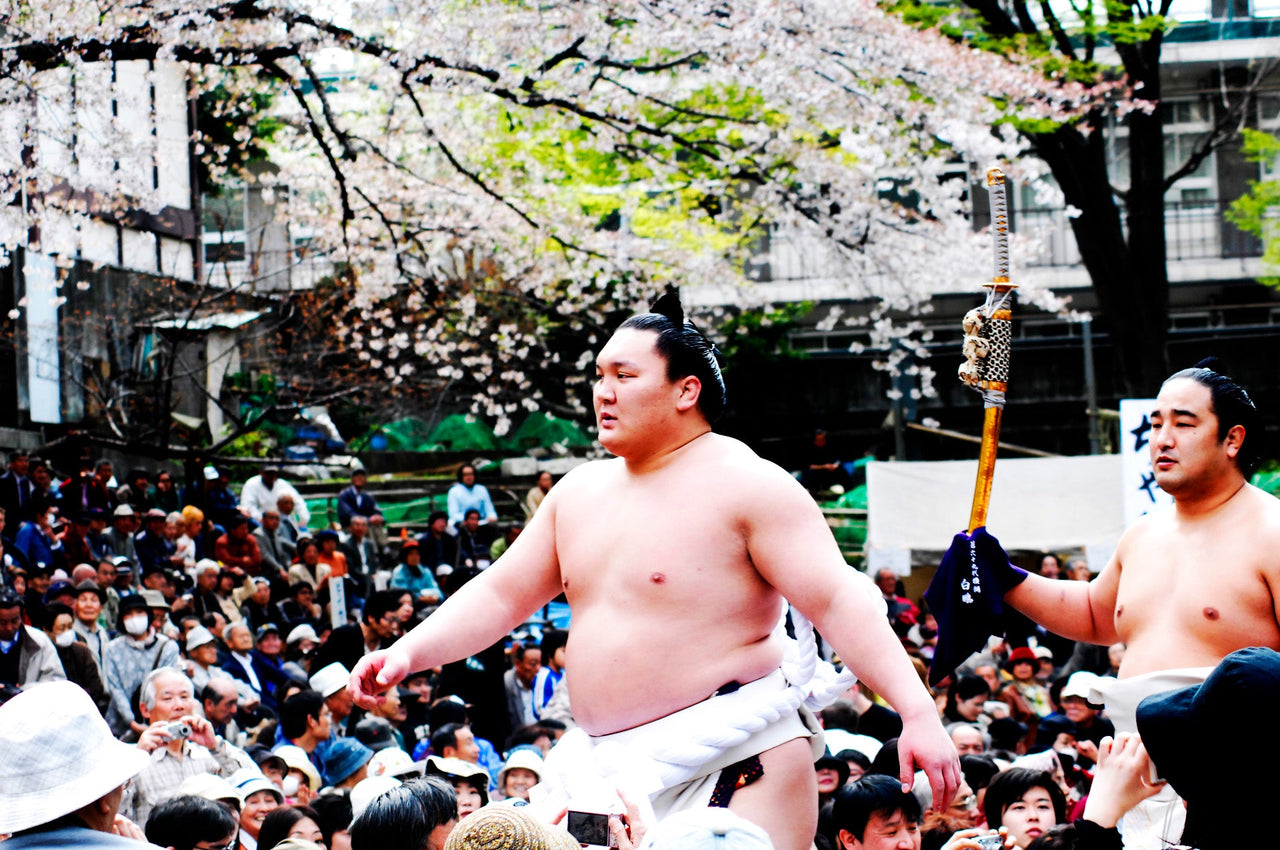
Yokozuna Hakuho XIV
During the ring-entering procession for the annual spring festival at Yasukuni Shrine. Just as Ogata described his first impression of Hakuho as "a beautiful sumo wrestler with cherry-pink skin that radiates a warm glow," Hakuho seems to be absorbing the gentle spring sunlight and the fragrance of the cherry blossoms. Yasukuni Shrine, 2008.
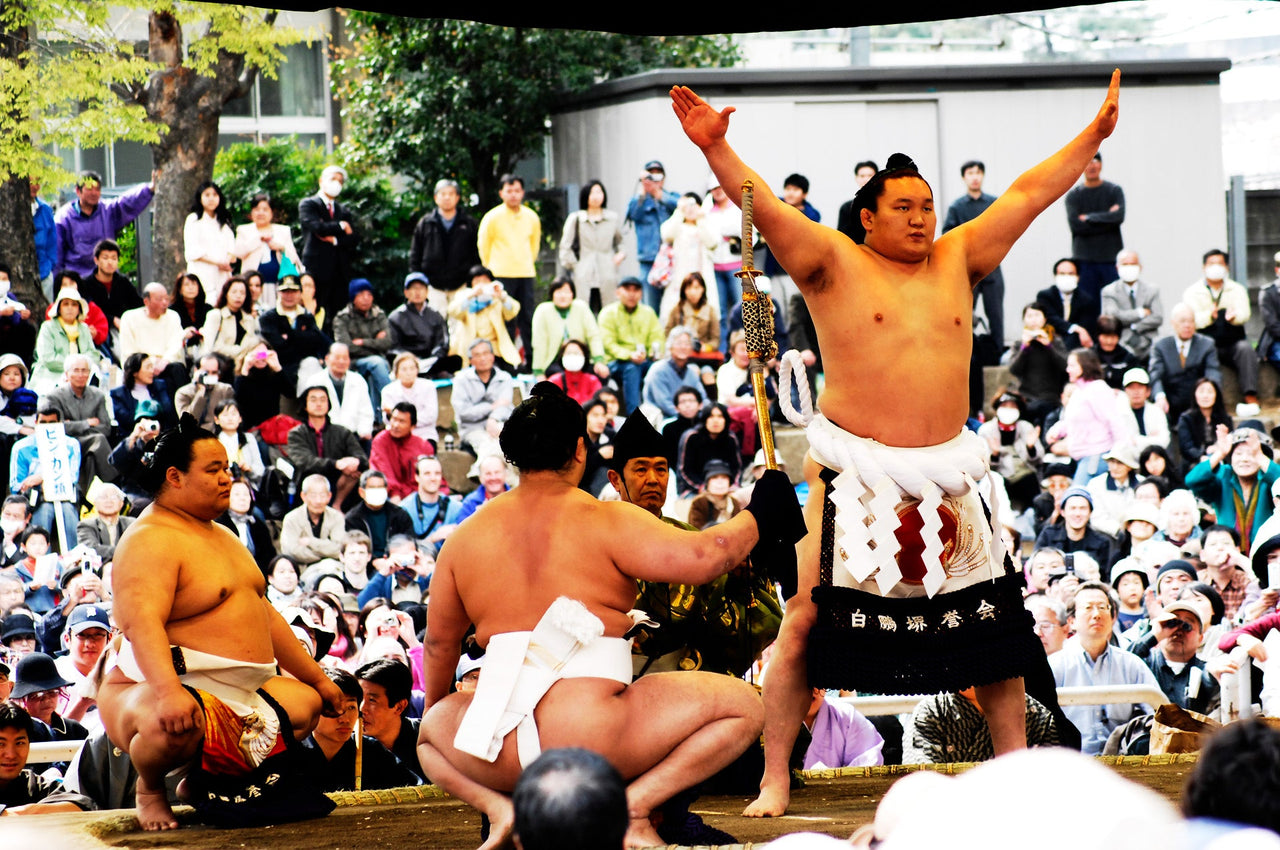
Yokozuna Hakuho XV
This is a dedication sumo tournament that began to console the spirits of Yasukuni Shrine. In the sumo arena that has been there since the shrine was first built, in addition to the bouts, there are also events that are not seen in the main tournament, such as the first cut, sumo chants, and the beating of yagura taiko drums. The 2008 Yokozuna Dohyo-iri. The Shiranui style that will be performed is the same style as Yokozuna Yoshibayama, a senior in the stable.
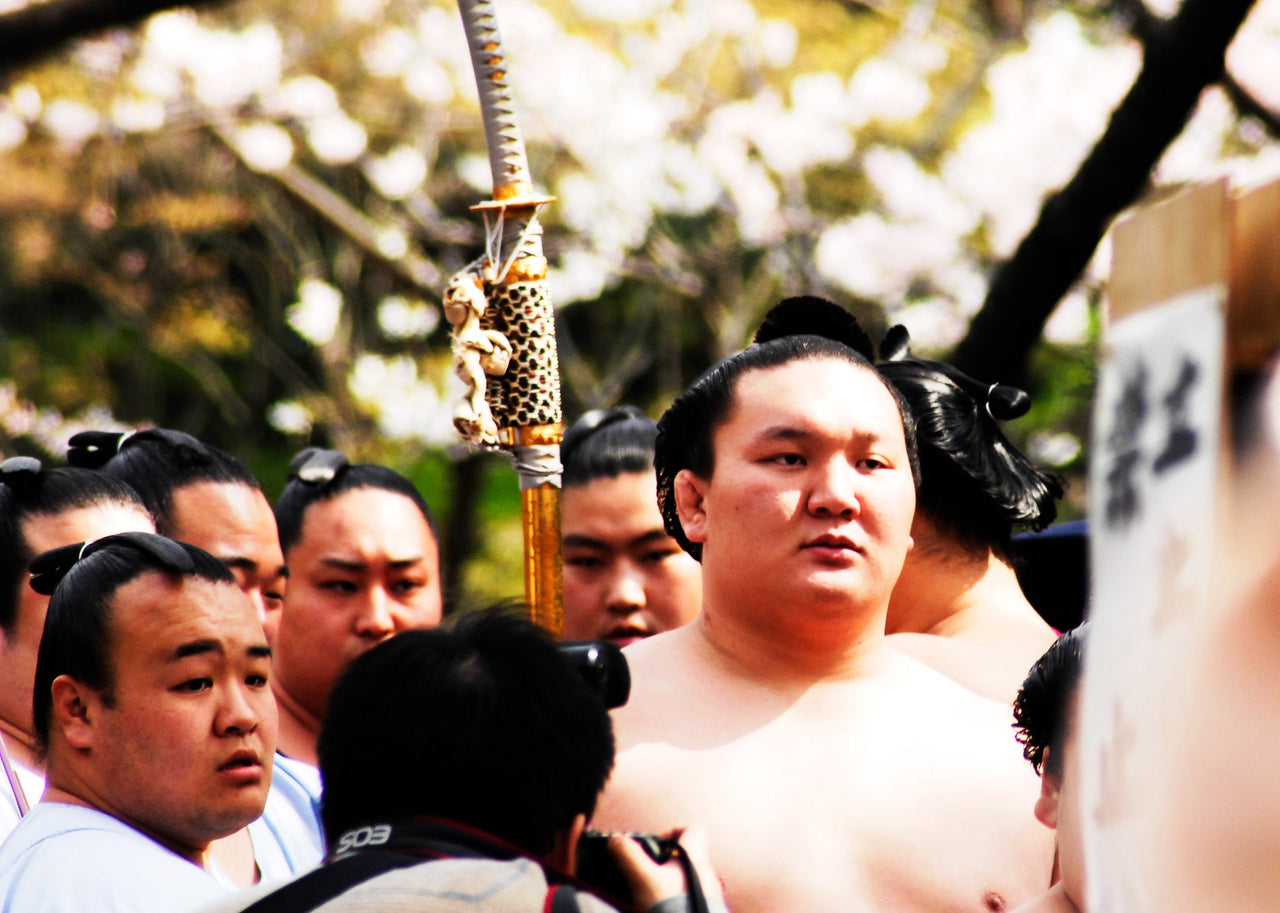
Yokozuna Hakuho XVI
At a sumo dedication ceremony at Yasukuni Shrine in 2008, the yokozuna makes his way to the ring accompanied by his sword bearer and dew sweeper. Many fans look forward to this spring spectacle where they can feel the power of the yokozuna up close. It's been a year since they met. You can tell that Ogata finds joy in capturing "the sight of him shining ever brighter" in photographs.
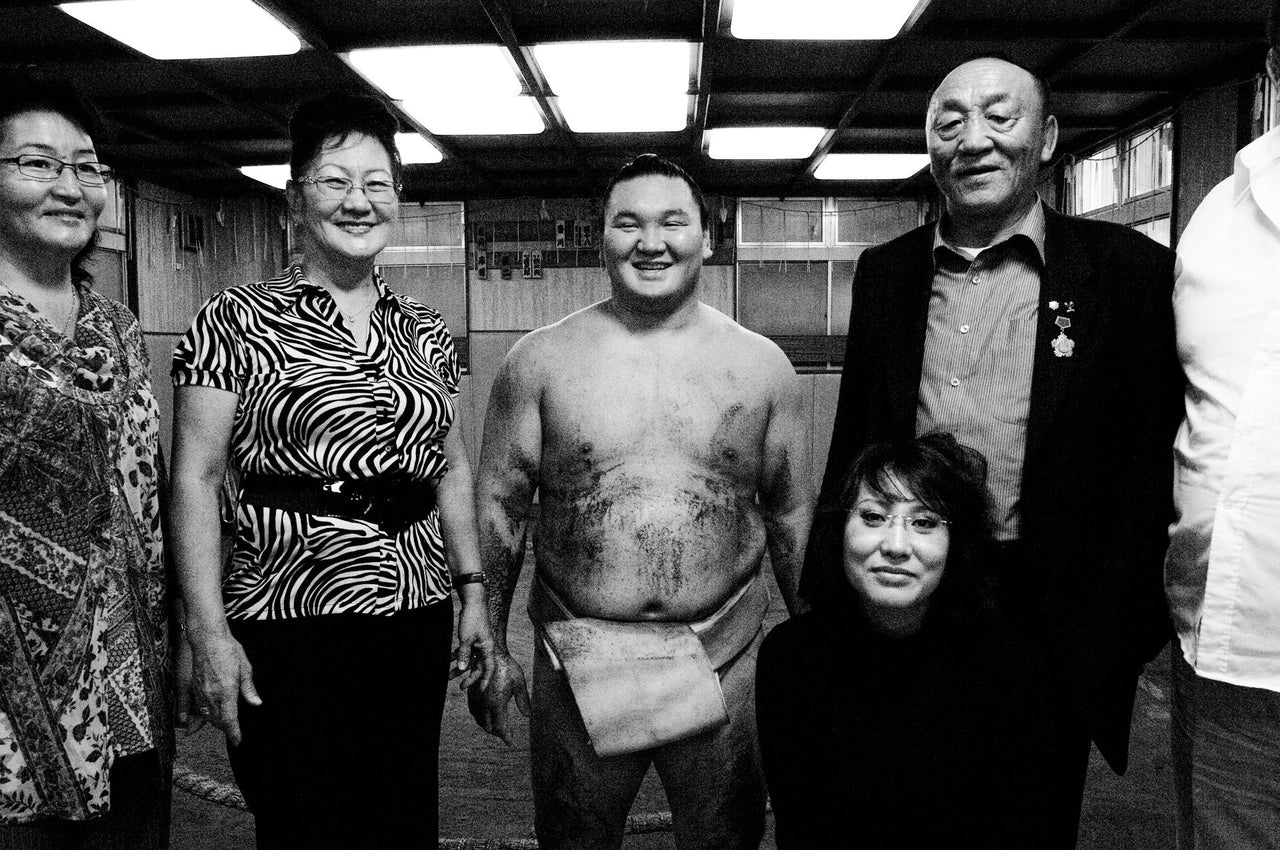
Yokozuna Hakuho XVII
Hakuho's father, a Mongolian sumo champion and Olympic silver medalist in wrestling, is a hero to him. He endured tough days of training in a world of different languages and cultures. Even when he wanted to run away, he endured because he knew he must not smear his father's reputation. His family remained the nucleus. At Miyagino stable with his parents and older sister in 2010.
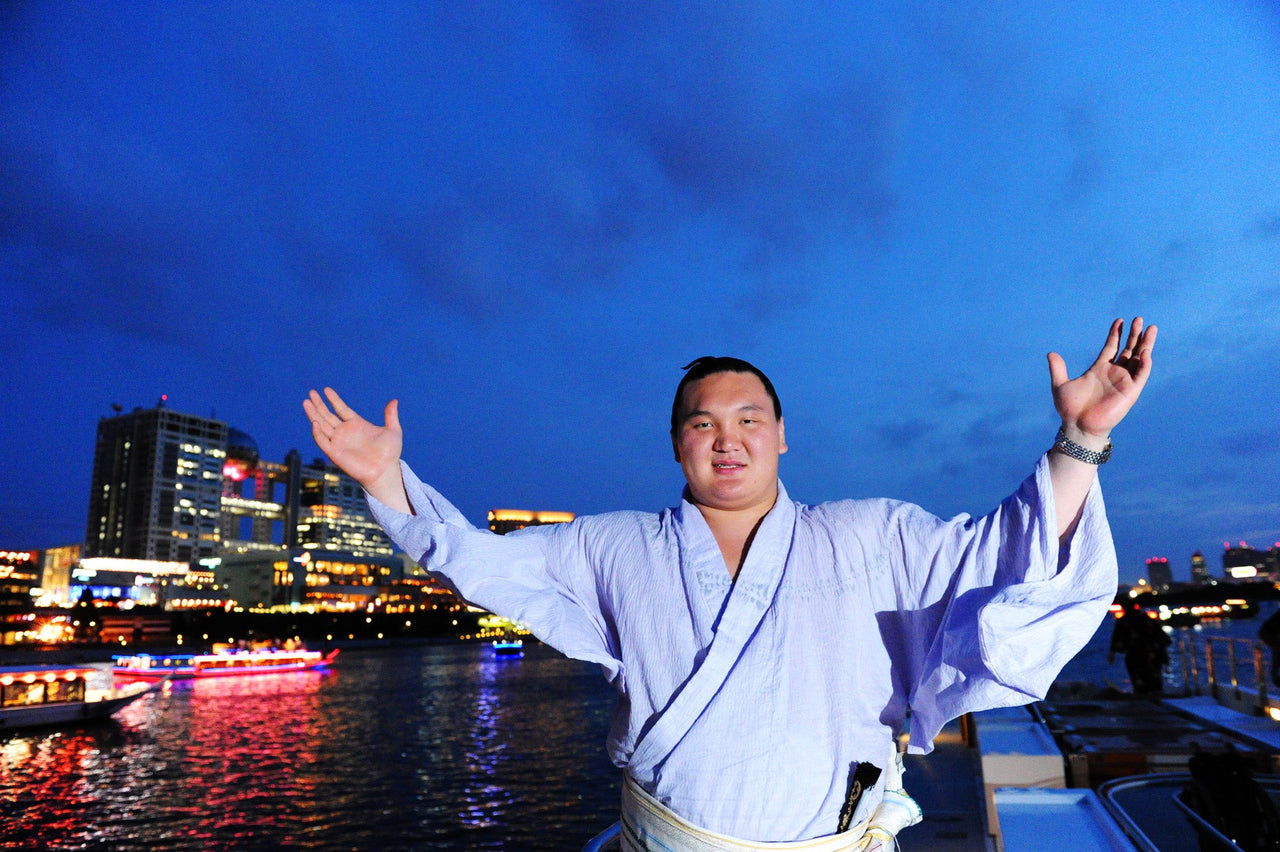
Yokozuna Hakuho XVIII
Ogata says that "the sky suits him well" because when he was struggling during his early years, he would often look up at the night sky that his parents would be looking at in his hometown. It is as if the night sky is beginning to dye Hakuho's yukata. At an event on a houseboat where he interacted with fans in 2010.
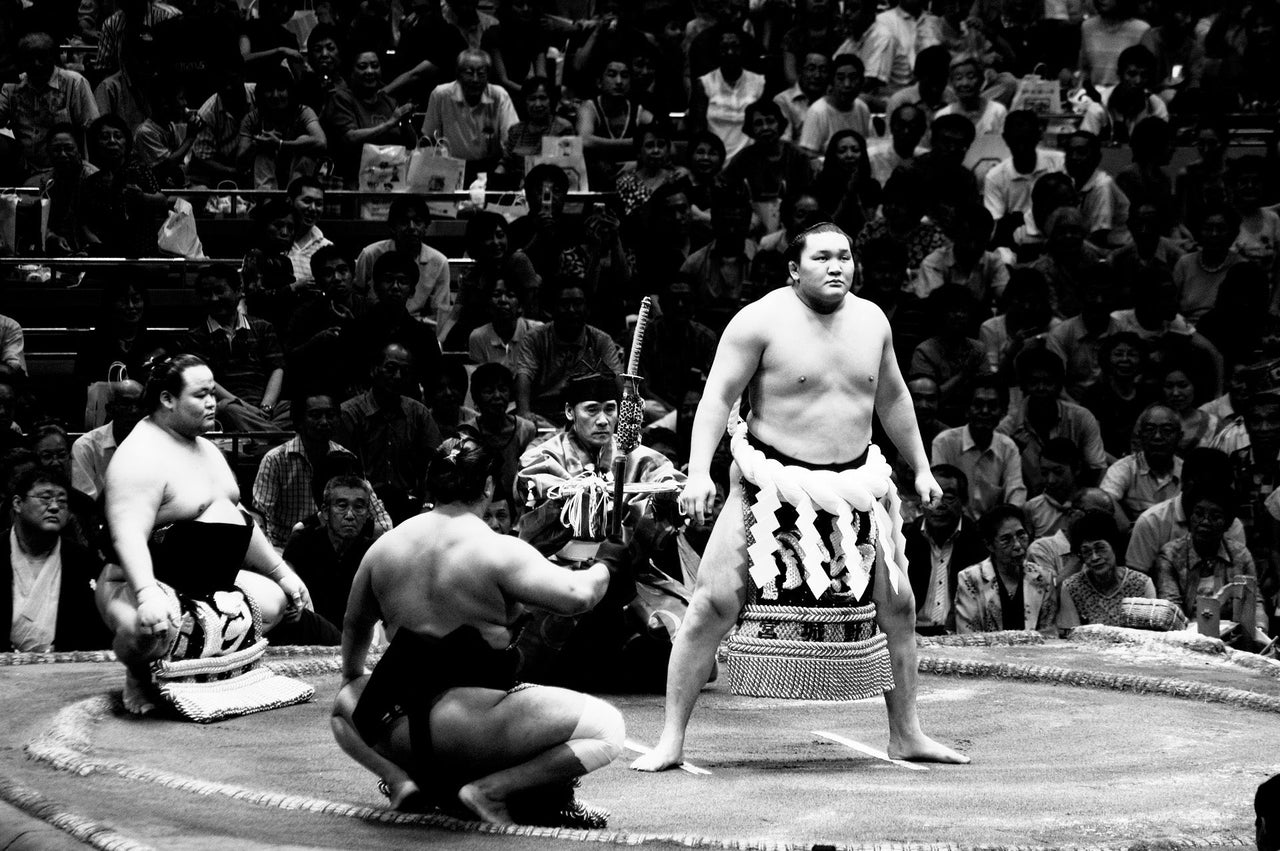
Yokozuna Hakuho XIX
Yokozuna dohyo-iri at the September 2010 tournament. Asashoryu retired that year, and he became the only Yokozuna from the March tournament. It was the first time in history that a Shiranui-style Yokozuna was the only Yokozuna in the rankings. In the November tournament, his winning streak came to an end at 63, and he commented to the press, "I guess this is a loss." It was a year of records and memories.
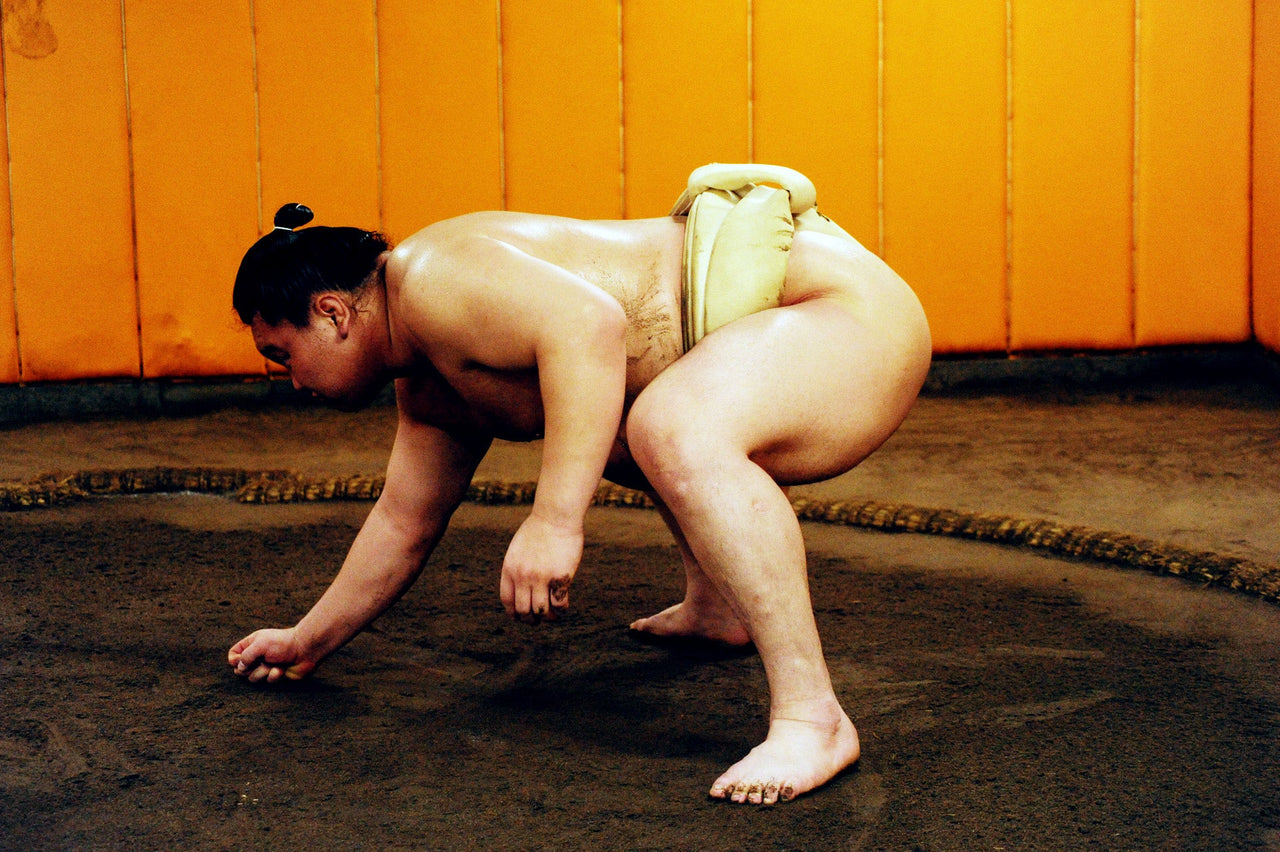
Yokozuna Hakuho XX
Filmed from an angle suggested by Hakuho. They decide on their foot positions, bend their hips, lower their arms, glare at each other, and stand up. Their backs and hips are straight and parallel to the ground, low and in a straight line. This is the formal beauty of sumo, and the aesthetics of a yokozuna standing to receive his opponent. At Miyagino stable in 2010.
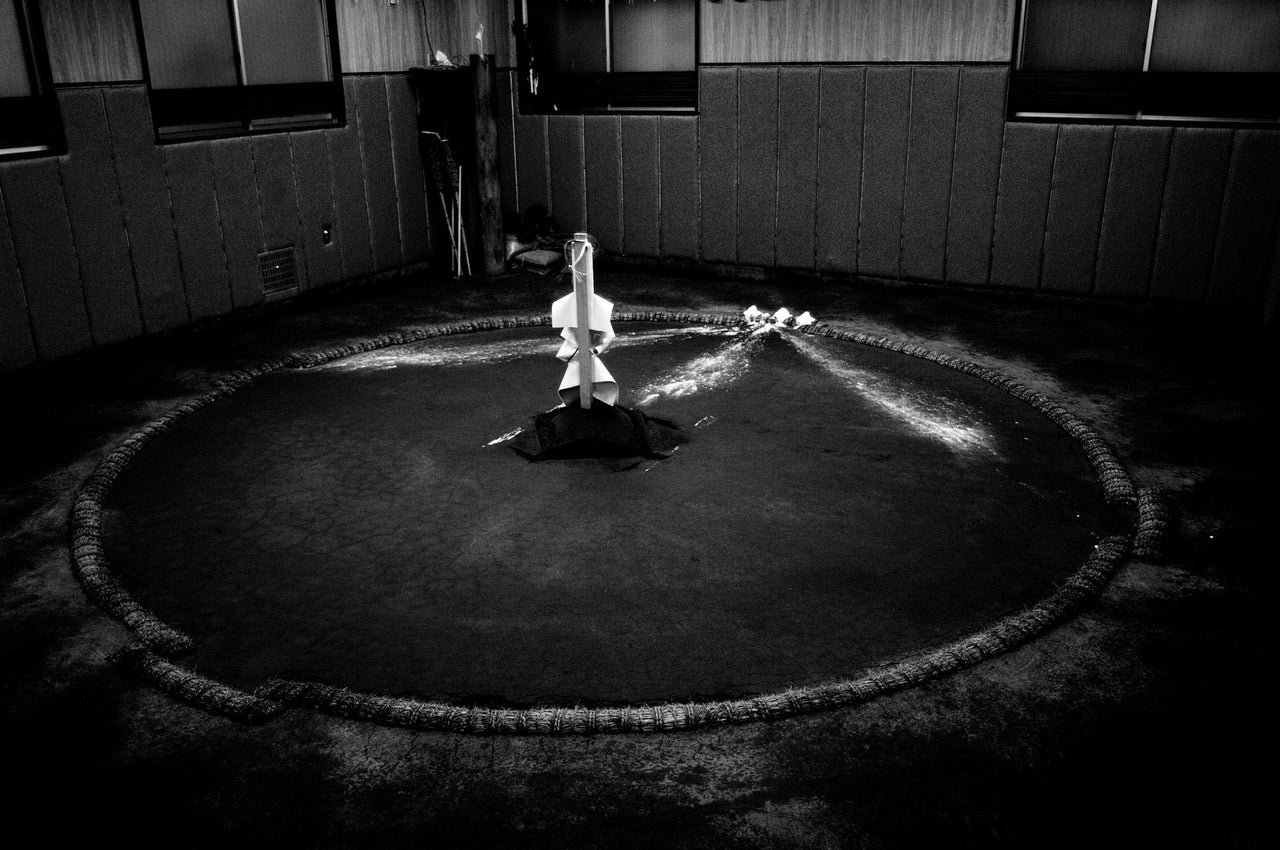
Yokozuna Hakuho XXI
The sumo ring after practice at Miyagino stable. Sand is piled up in the center of the ring, tamped down with boards, and after placing a gohei (sacred wrestler's wrestling stick), purified salt is scattered on three sides from the tokutawara (sacred wrestler's wrestling sack). It is a prayer and gratitude for the place where daily training takes place. Ogata's monochrome work invites us deeper into the sacredness that resides in the ring. At Miyagino stable in 2010.
Purchase Information
・You can choose to pay by credit card or bank transfer.
- It will take 3 to 4 weeks for delivery. Please note that it will take time as each item is handcrafted under the supervision of an artist.
・Delivery will be arranged by the delivery company designated by our company.
・For large-sized works, delivery dates and times are limited to weekdays and time cannot be specified. Please be aware of this.
About Hidemi Ogata's Photo Exhibition "Yokozuna Hakuho"
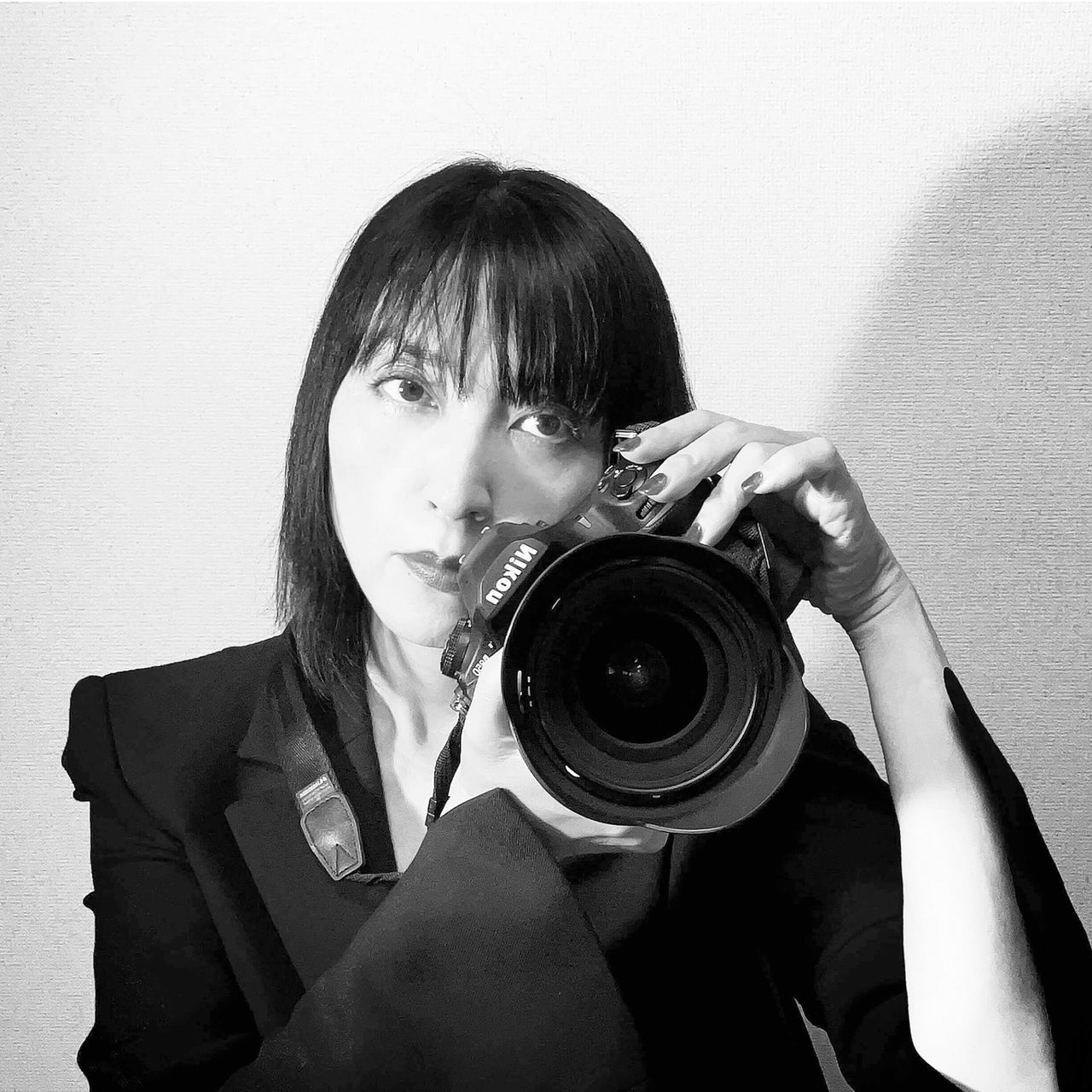
-
Photo exhibition “Yokozuna Hakuho” art book
Photo exhibition “Yokozuna Hakuho” art book
Vendor:緒方秀美- Regular price
- ¥1,650
- Sale price
- ¥1,650
- Regular price
-
-
Yokozuna Hakuho I
Yokozuna Hakuho I
Vendor:Hidemi Ogata- Regular price
- From ¥66,000
- Sale price
- From ¥66,000
- Regular price
-
-
Yokozuna Hakuho II
Yokozuna Hakuho II
Vendor:Hidemi Ogata- Regular price
- From ¥66,000
- Sale price
- From ¥66,000
- Regular price
-
-
Yokozuna Hakuho III
Yokozuna Hakuho III
Vendor:Hidemi Ogata- Regular price
- From ¥66,000
- Sale price
- From ¥66,000
- Regular price
-
-
Yokozuna Hakuho IV
Yokozuna Hakuho IV
Vendor:Hidemi Ogata- Regular price
- From ¥66,000
- Sale price
- From ¥66,000
- Regular price
-
-
Yokozuna Hakuho IX
Yokozuna Hakuho IX
Vendor:Hidemi Ogata- Regular price
- From ¥66,000
- Sale price
- From ¥66,000
- Regular price
-
-
Yokozuna Hakuho V
Yokozuna Hakuho V
Vendor:Hidemi Ogata- Regular price
- From ¥66,000
- Sale price
- From ¥66,000
- Regular price
-
-
Yokozuna Hakuho VI
Yokozuna Hakuho VI
Vendor:Hidemi Ogata- Regular price
- From ¥66,000
- Sale price
- From ¥66,000
- Regular price
-
-
Yokozuna Hakuho VII
Yokozuna Hakuho VII
Vendor:Hidemi Ogata- Regular price
- From ¥66,000
- Sale price
- From ¥66,000
- Regular price
-
-
Yokozuna Hakuho VIII
Yokozuna Hakuho VIII
Vendor:Hidemi Ogata- Regular price
- From ¥66,000
- Sale price
- From ¥66,000
- Regular price
-
-
Yokozuna Hakuho X
Yokozuna Hakuho X
Vendor:Hidemi Ogata- Regular price
- From ¥66,000
- Sale price
- From ¥66,000
- Regular price
-
-
Yokozuna Hakuho XI
Yokozuna Hakuho XI
Vendor:Hidemi Ogata- Regular price
- From ¥66,000
- Sale price
- From ¥66,000
- Regular price
-
-
Yokozuna Hakuho XII
Yokozuna Hakuho XII
Vendor:Hidemi Ogata- Regular price
- From ¥66,000
- Sale price
- From ¥66,000
- Regular price
-
-
Yokozuna Hakuho XIII
Yokozuna Hakuho XIII
Vendor:Hidemi Ogata- Regular price
- From ¥66,000
- Sale price
- From ¥66,000
- Regular price
-
-
Yokozuna Hakuho XIV
Yokozuna Hakuho XIV
Vendor:Hidemi Ogata- Regular price
- From ¥66,000
- Sale price
- From ¥66,000
- Regular price
-
-
Yokozuna Hakuho XIX
Yokozuna Hakuho XIX
Vendor:Hidemi Ogata- Regular price
- From ¥66,000
- Sale price
- From ¥66,000
- Regular price
-
-
Yokozuna Hakuho XV
Yokozuna Hakuho XV
Vendor:Hidemi Ogata- Regular price
- From ¥66,000
- Sale price
- From ¥66,000
- Regular price
-
-
Yokozuna Hakuho XVI
Yokozuna Hakuho XVI
Vendor:Hidemi Ogata- Regular price
- From ¥66,000
- Sale price
- From ¥66,000
- Regular price
-
-
Yokozuna Hakuho XVII
Yokozuna Hakuho XVII
Vendor:Hidemi Ogata- Regular price
- From ¥66,000
- Sale price
- From ¥66,000
- Regular price
-
-
Yokozuna Hakuho XVIII
Yokozuna Hakuho XVIII
Vendor:Hidemi Ogata- Regular price
- From ¥66,000
- Sale price
- From ¥66,000
- Regular price
-
-
Yokozuna Hakuho XX
Yokozuna Hakuho XX
Vendor:Hidemi Ogata- Regular price
- From ¥66,000
- Sale price
- From ¥66,000
- Regular price
-
-
Yokozuna Hakuho XXI
Yokozuna Hakuho XXI
Vendor:Hidemi Ogata- Regular price
- From ¥66,000
- Sale price
- From ¥66,000
- Regular price
-


